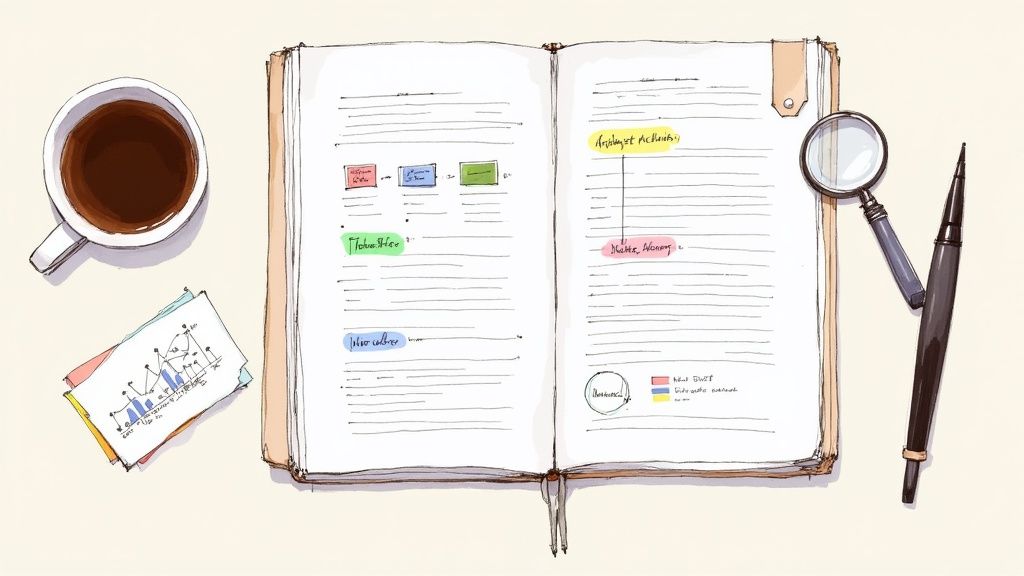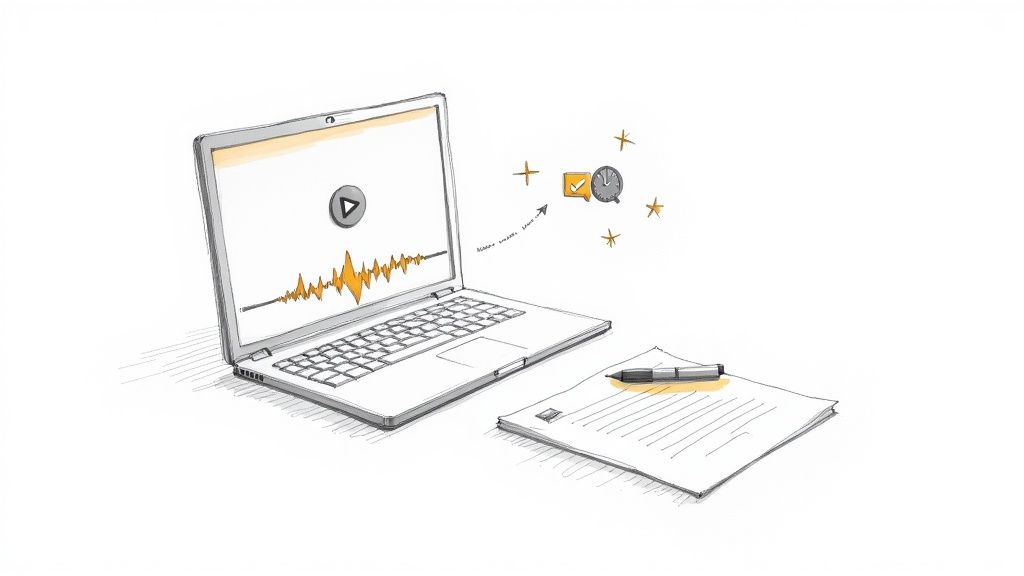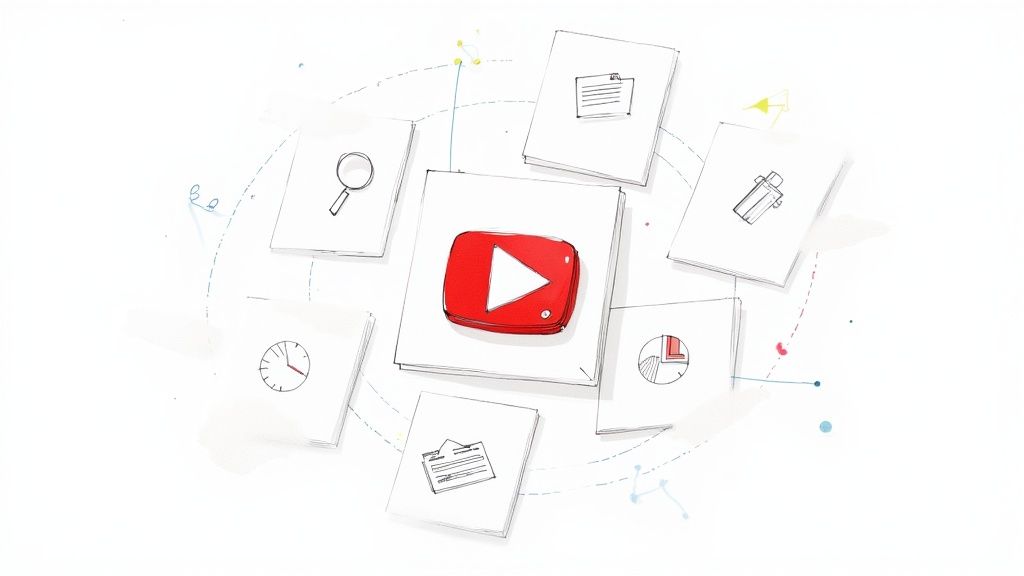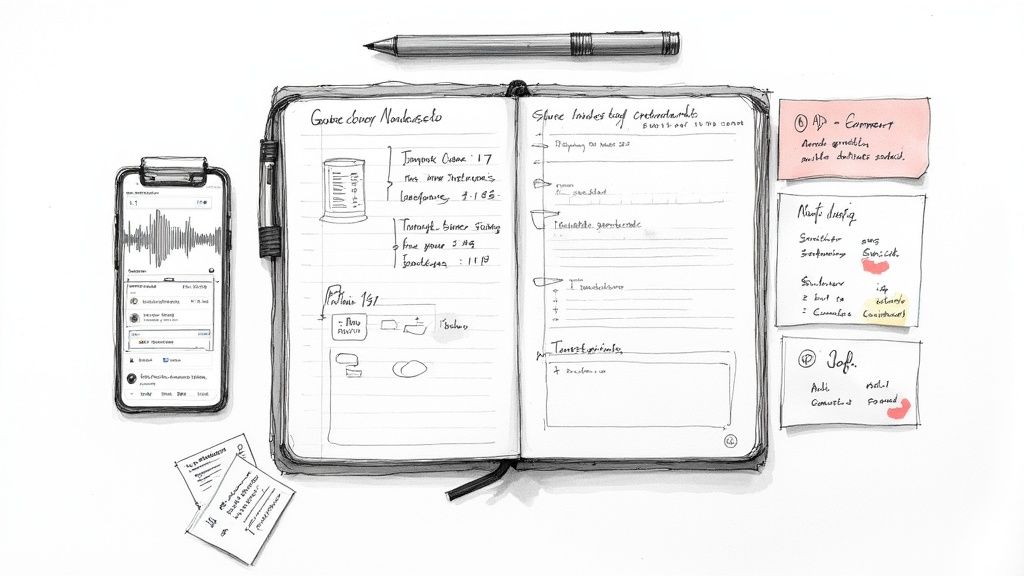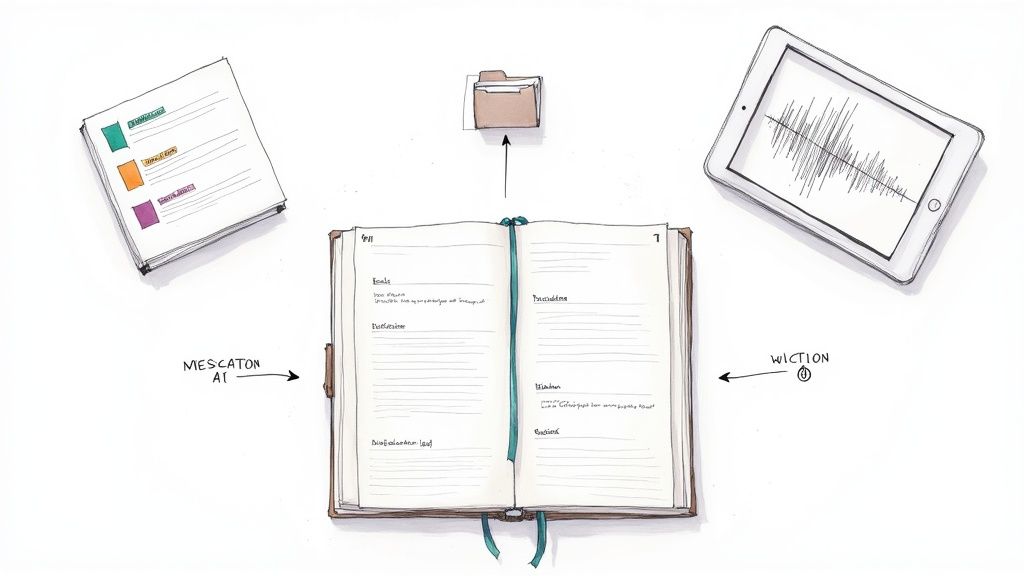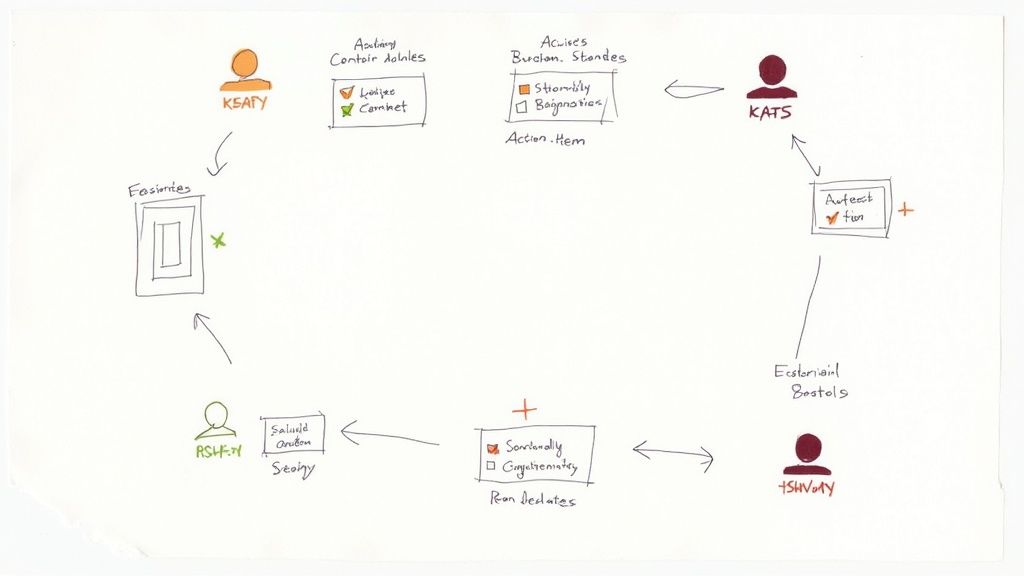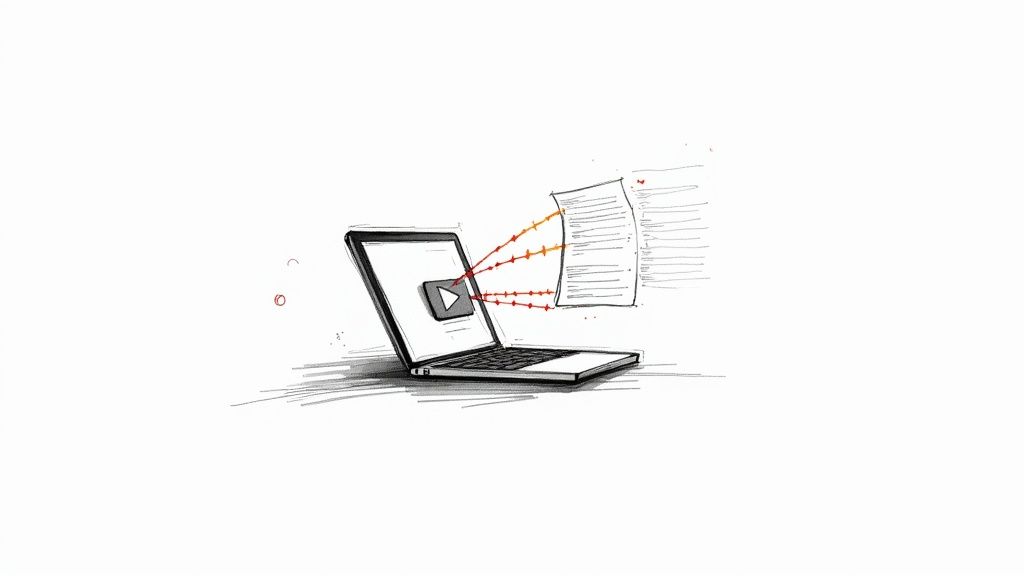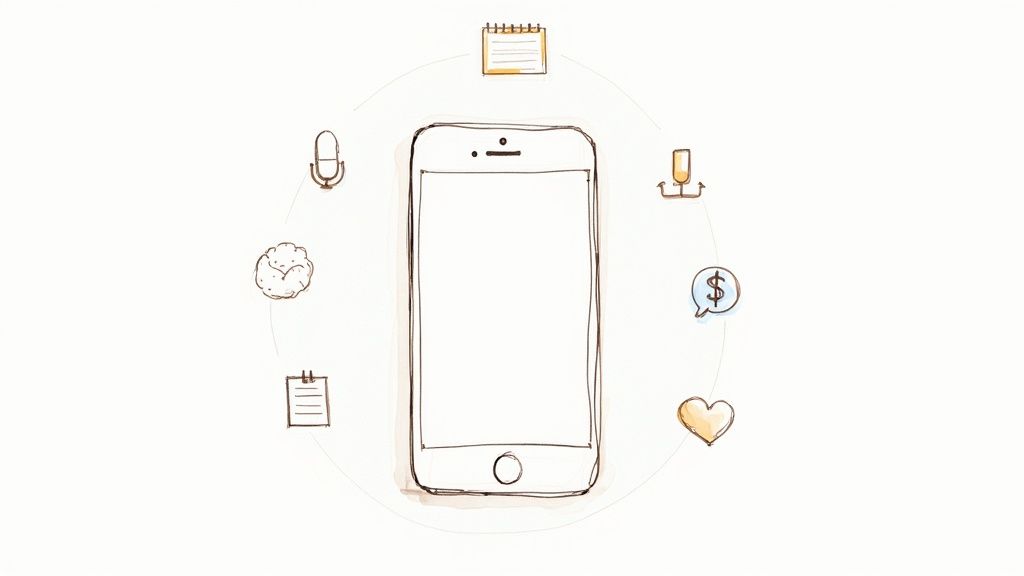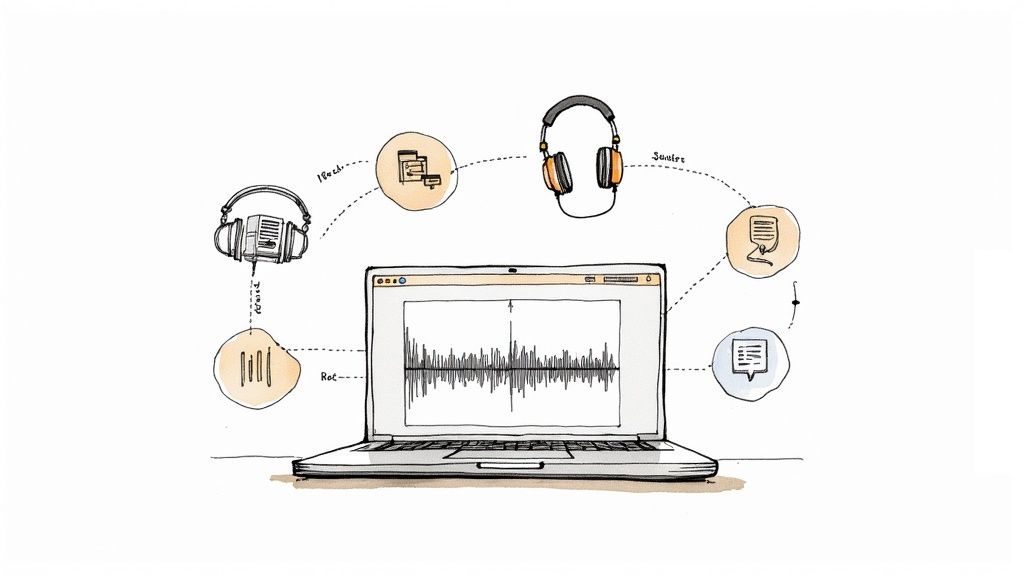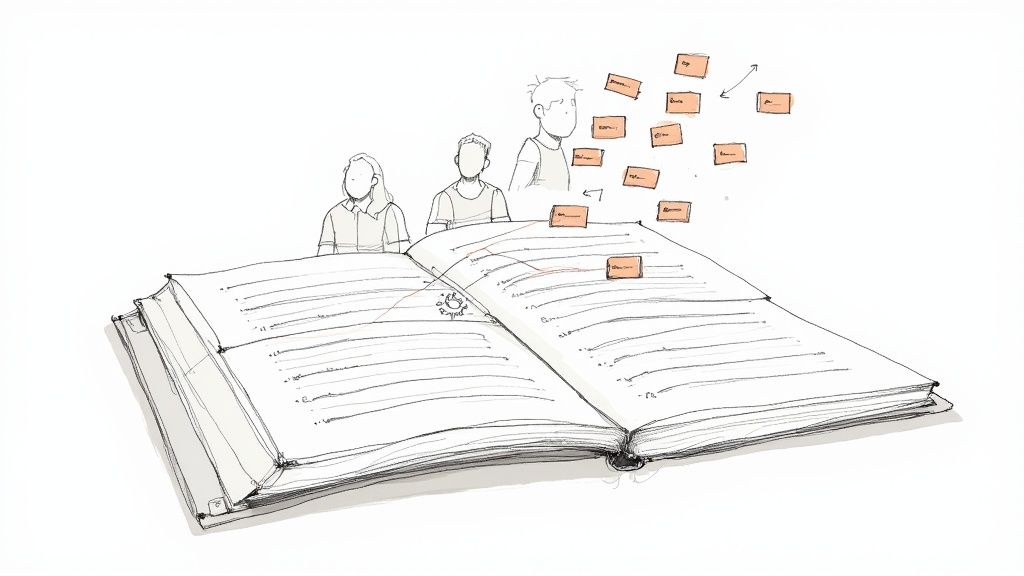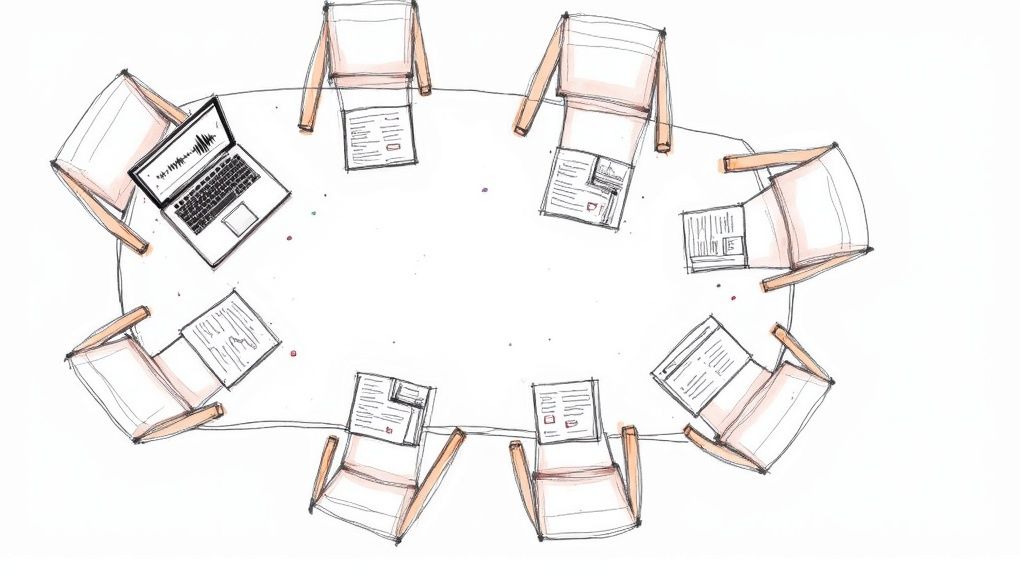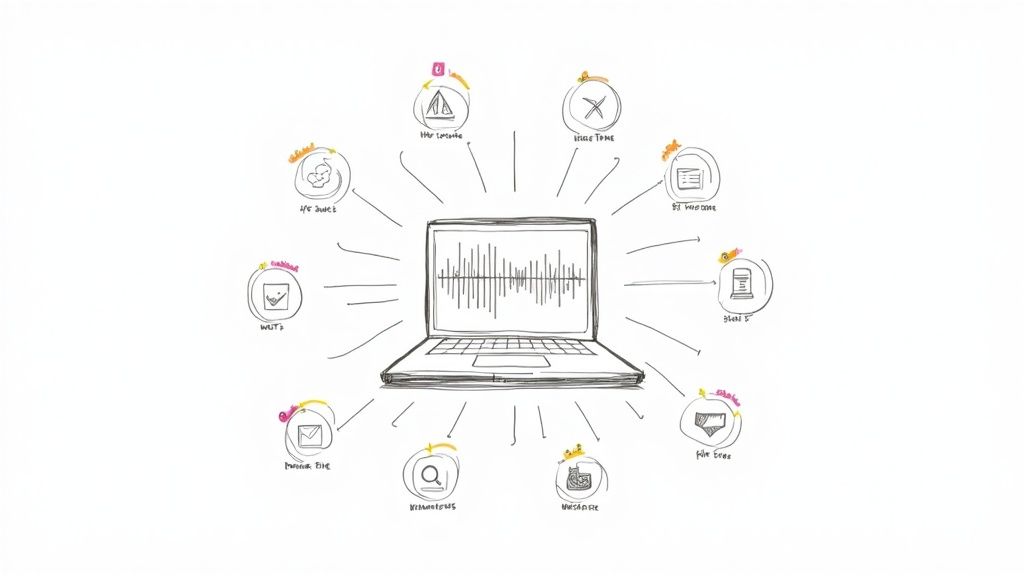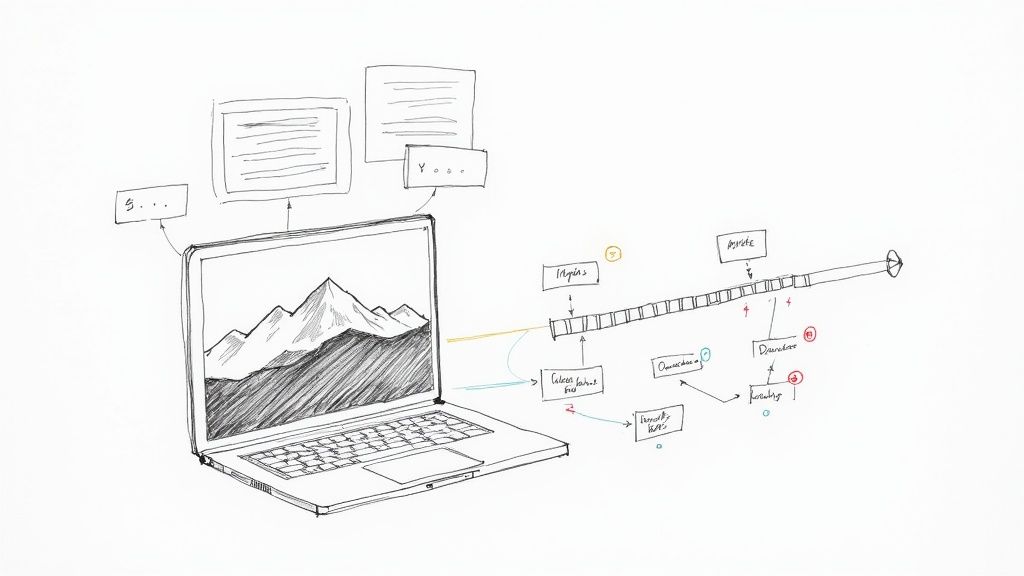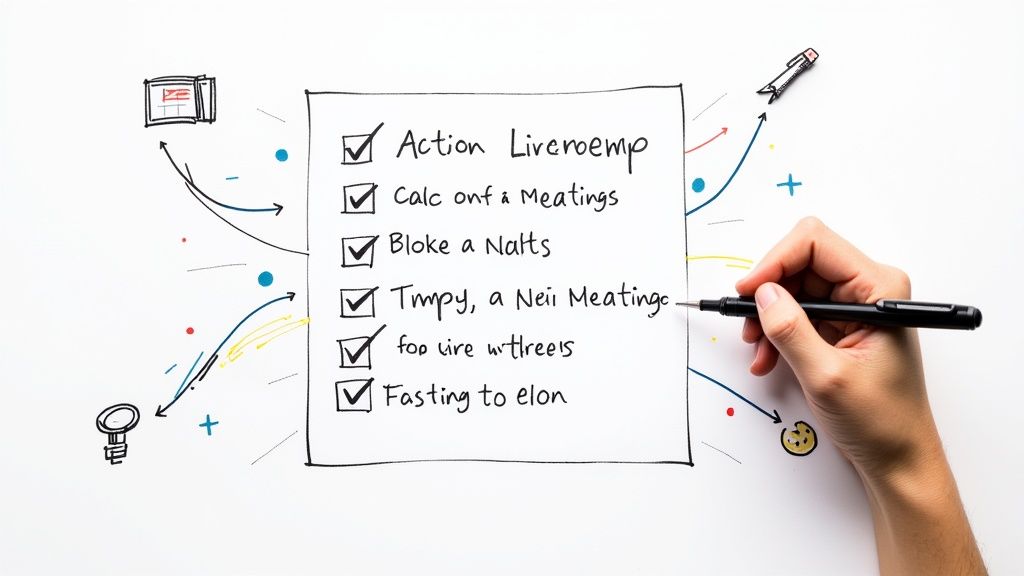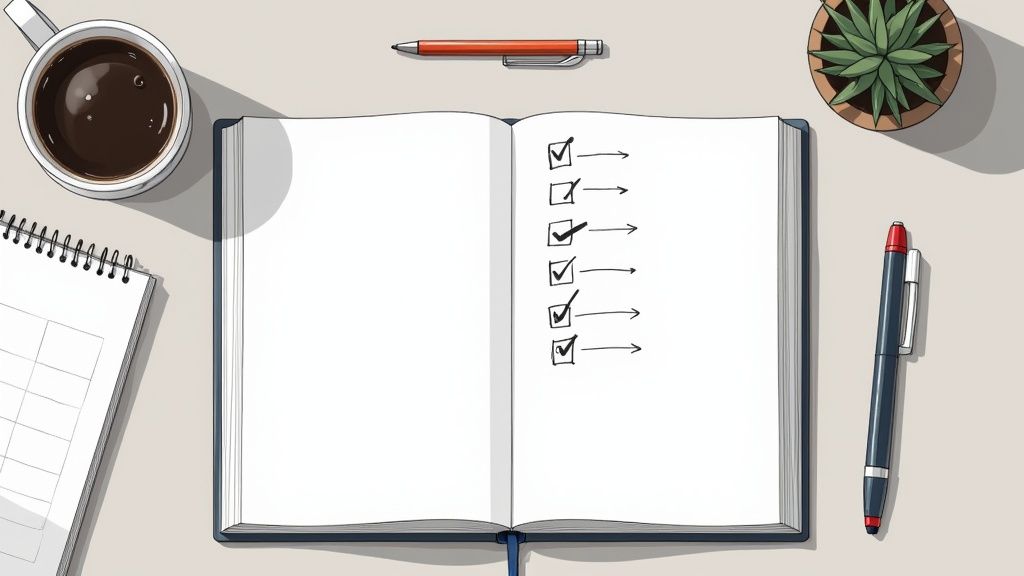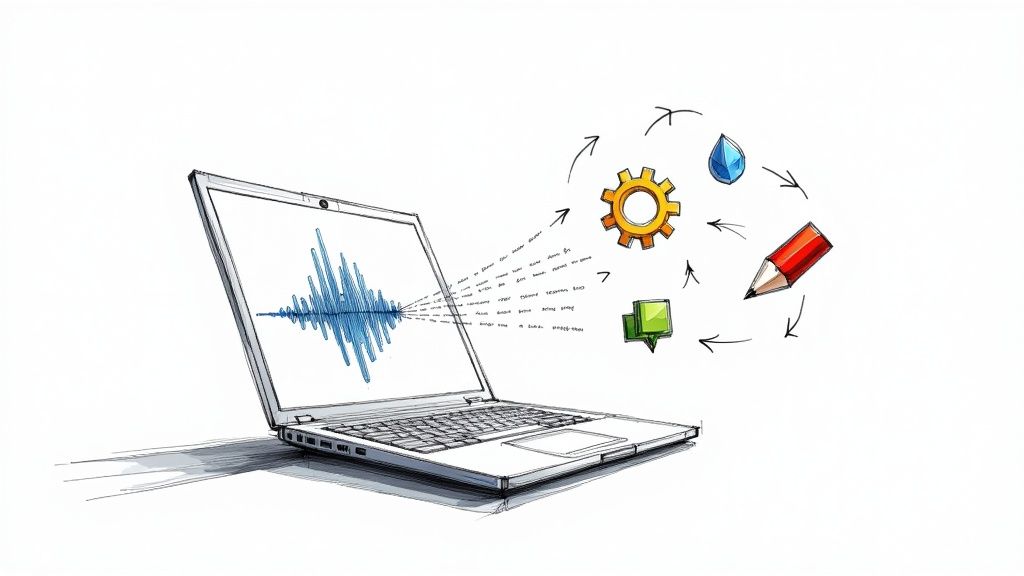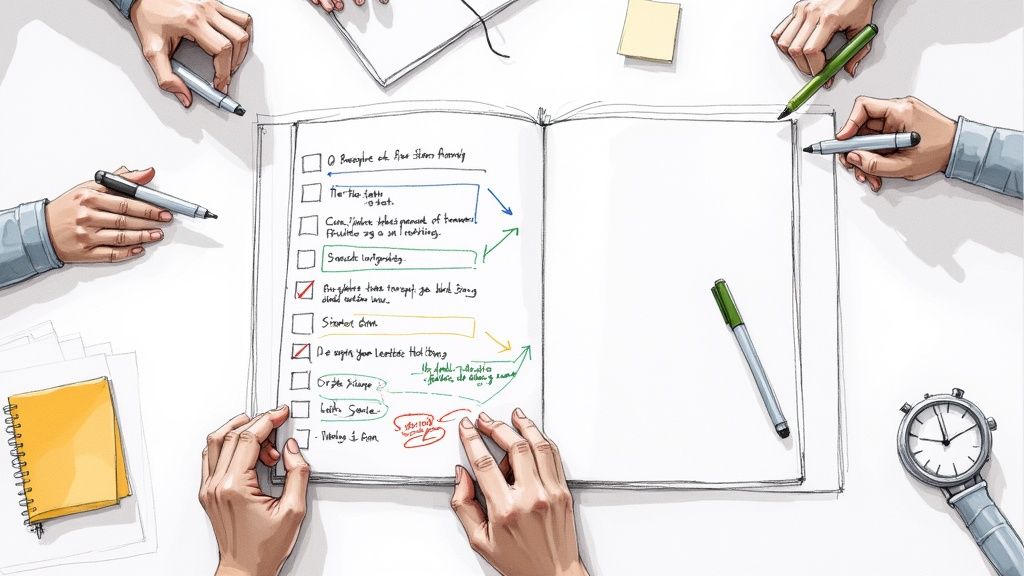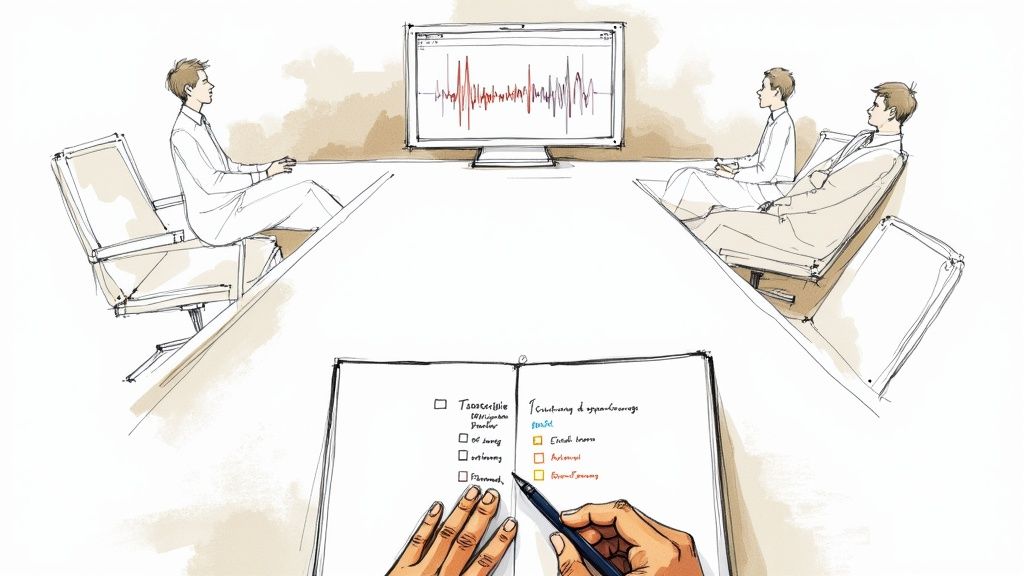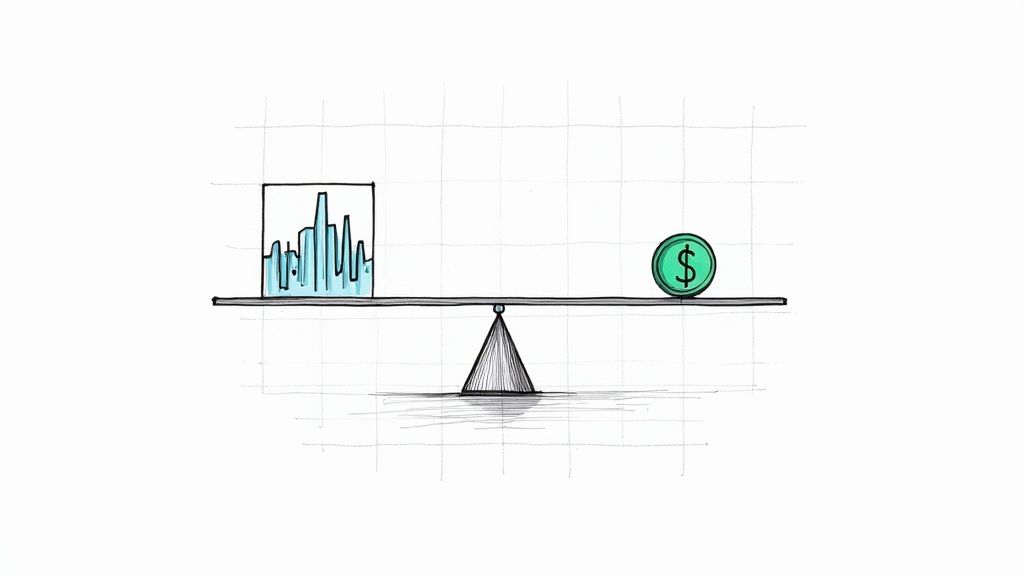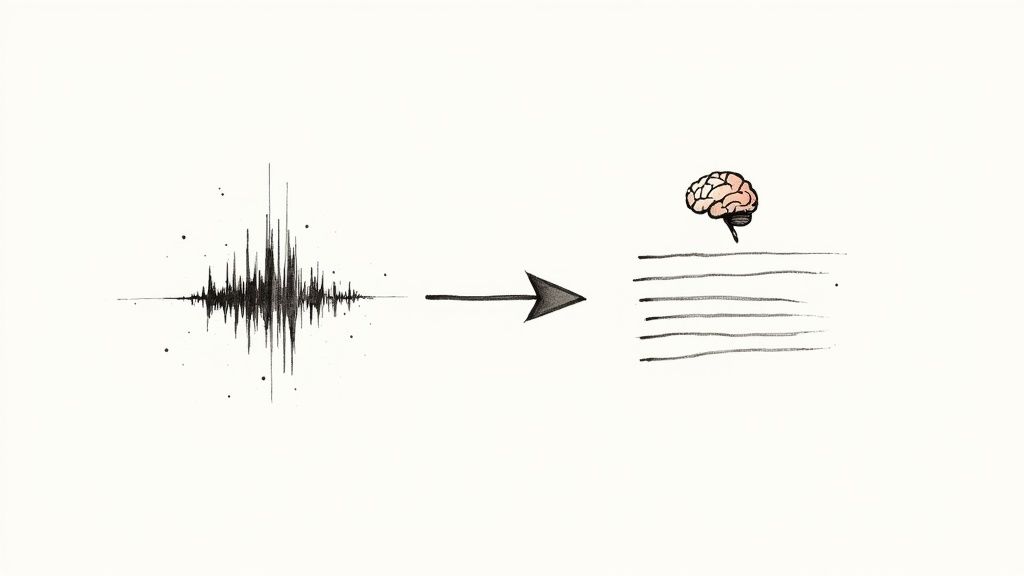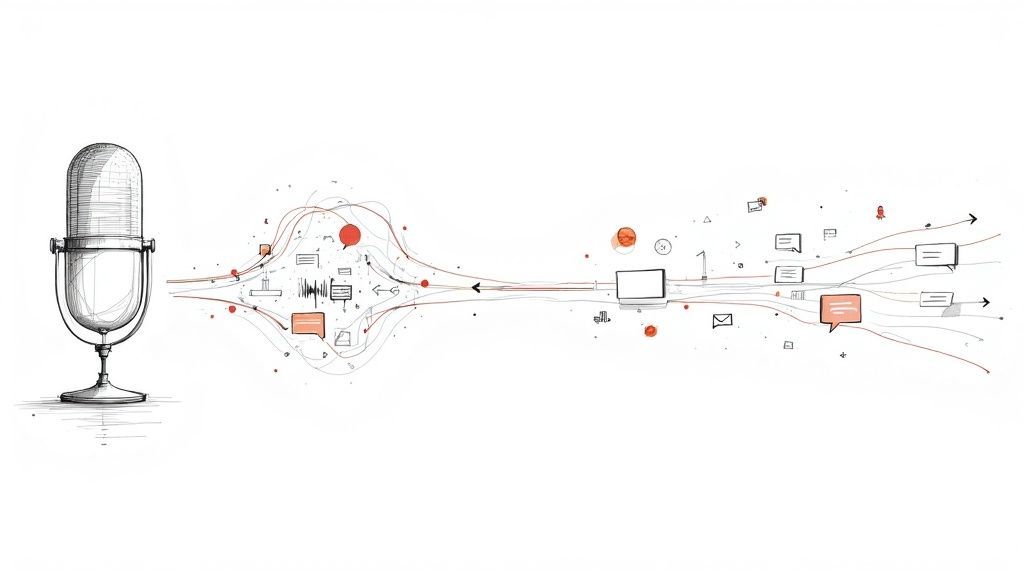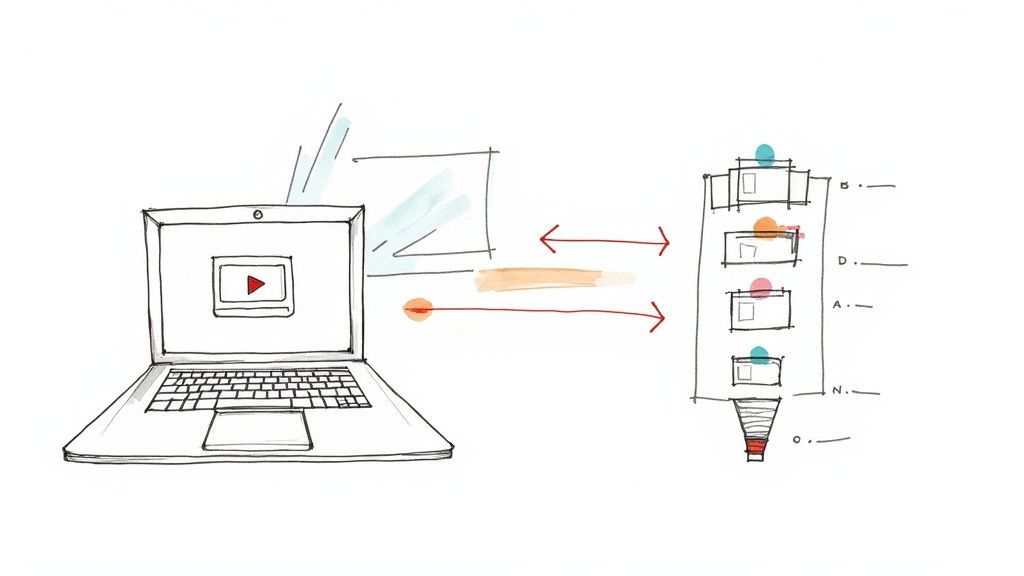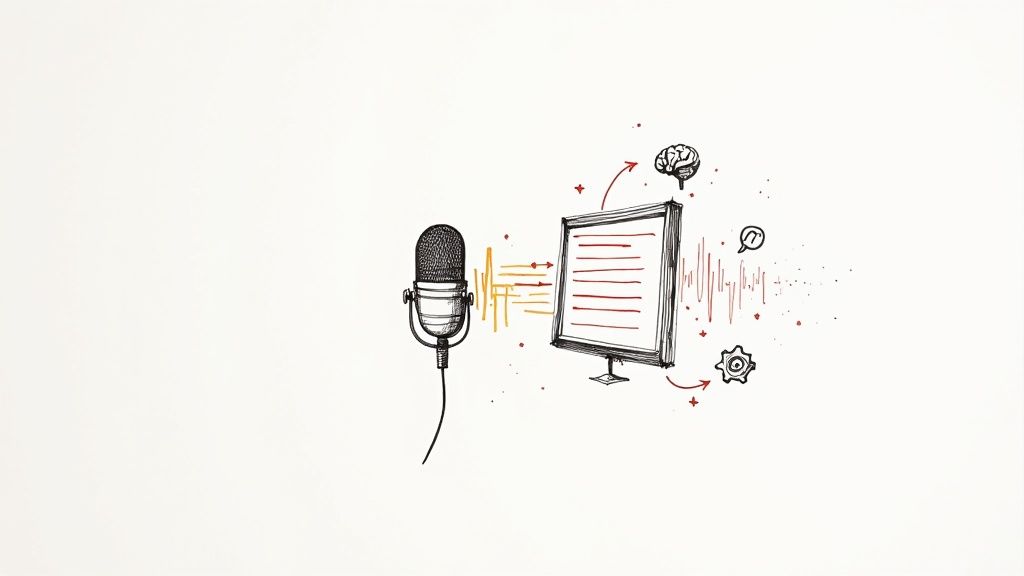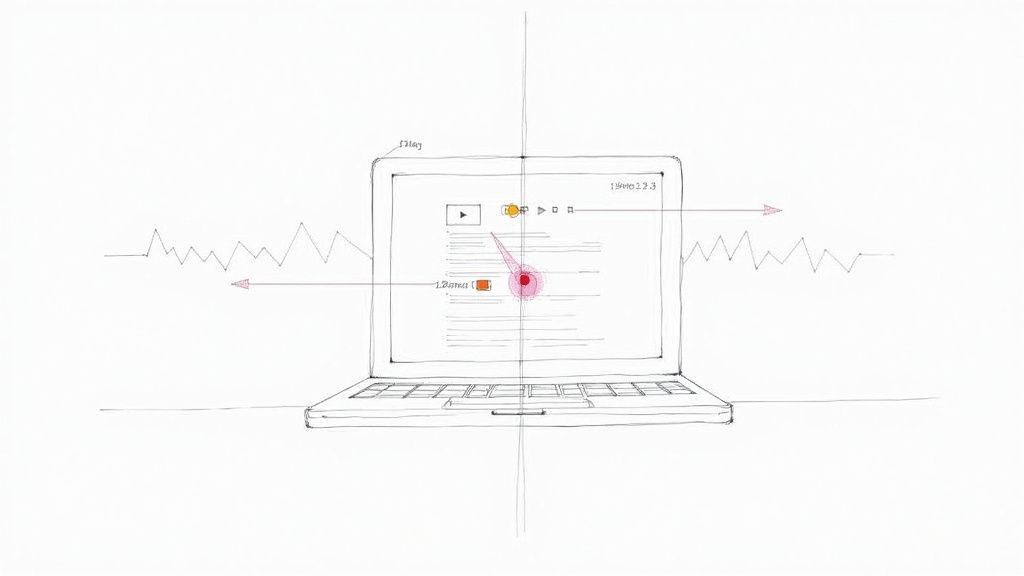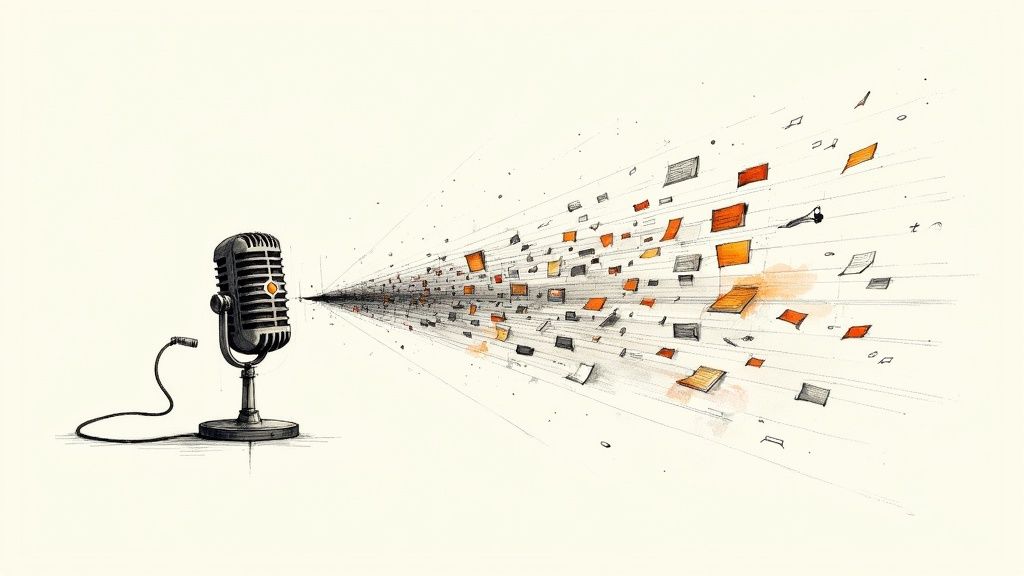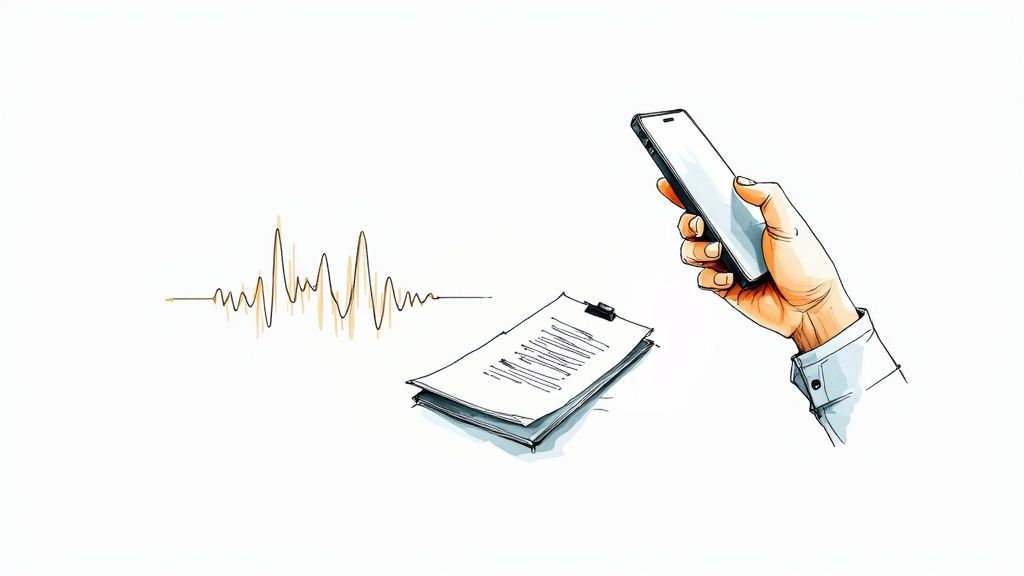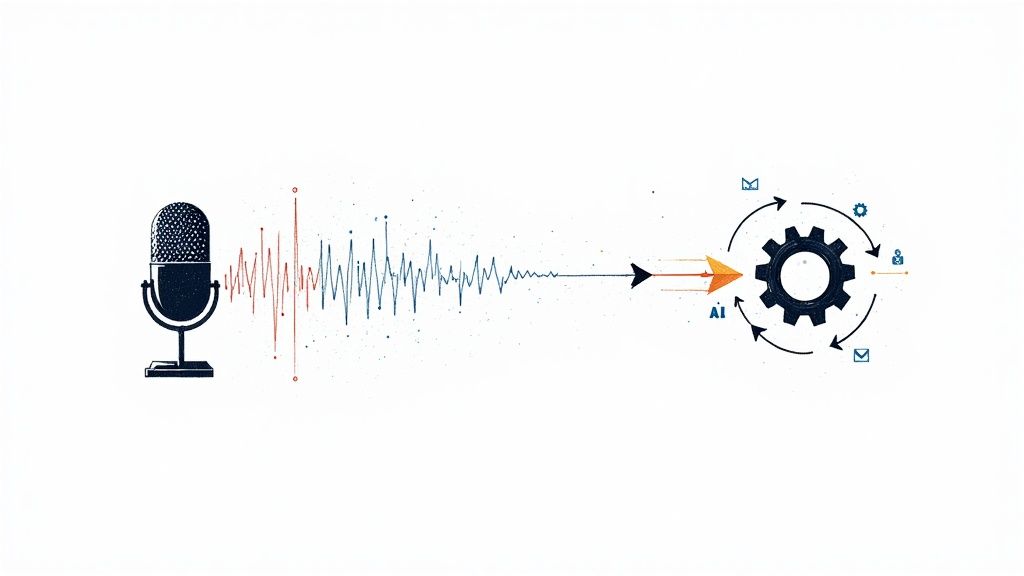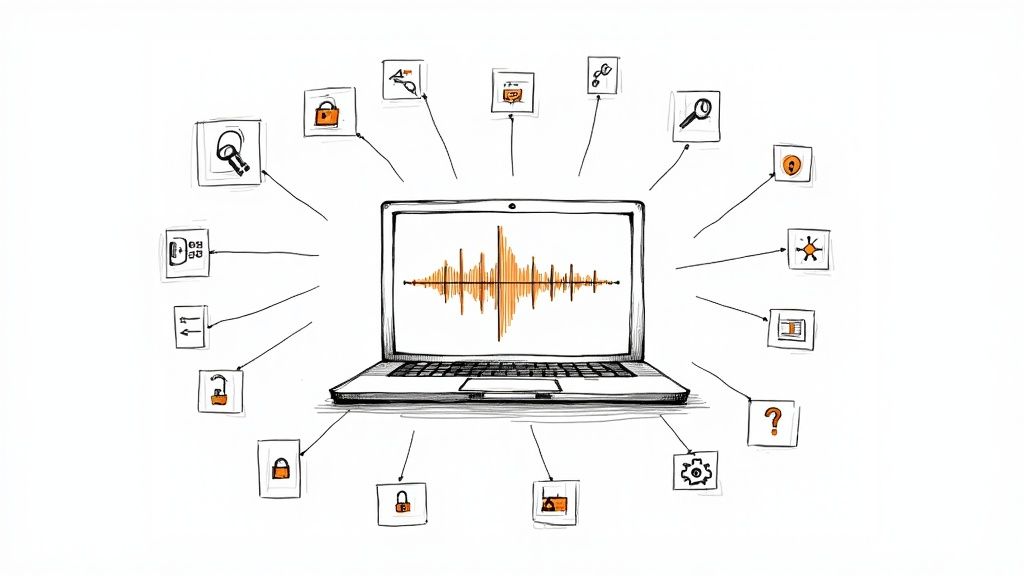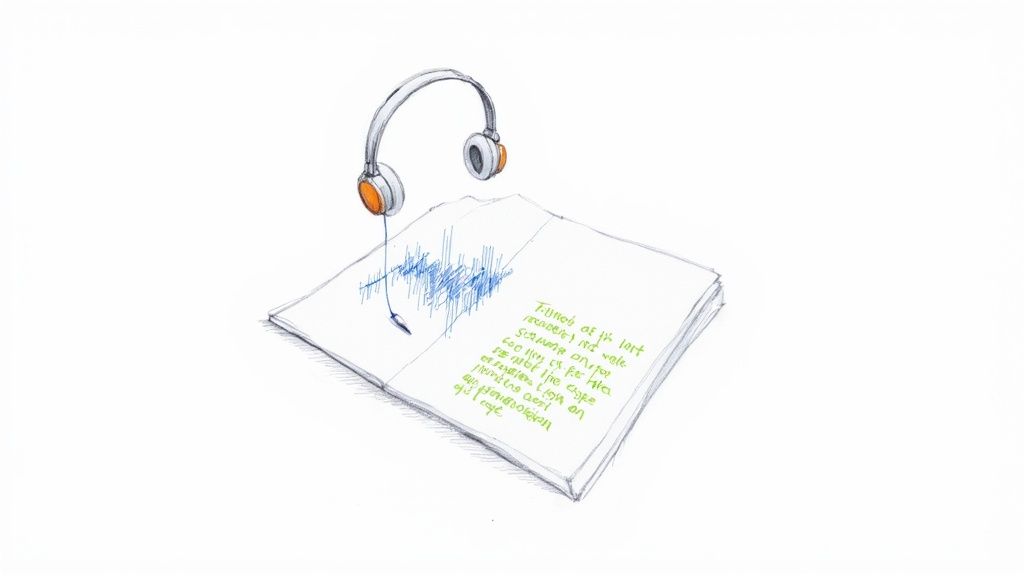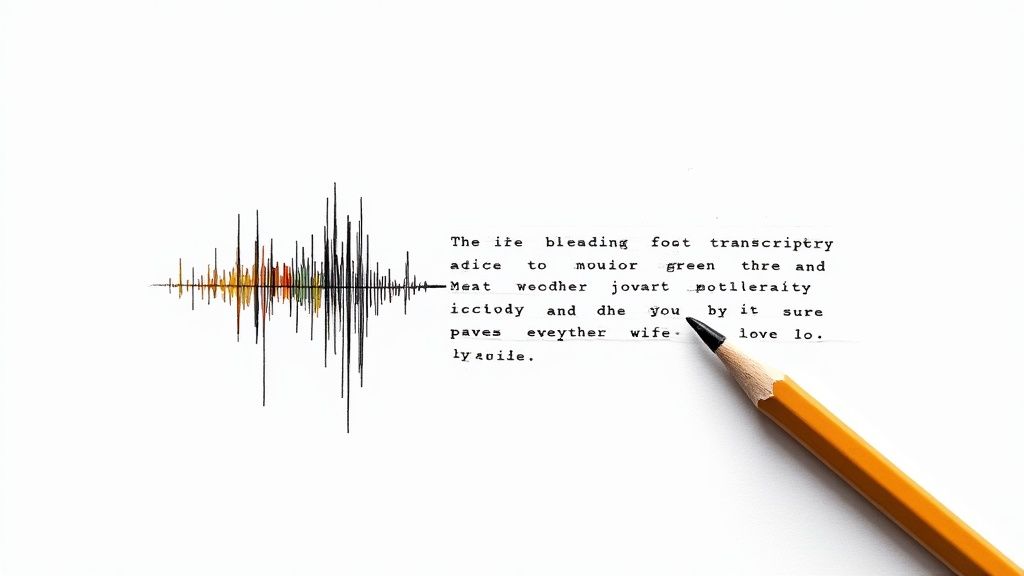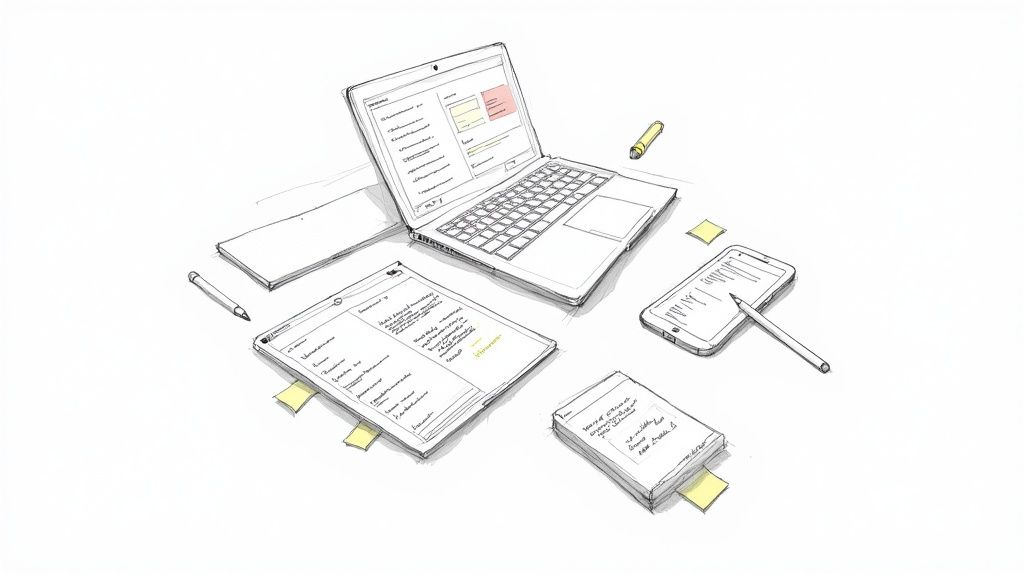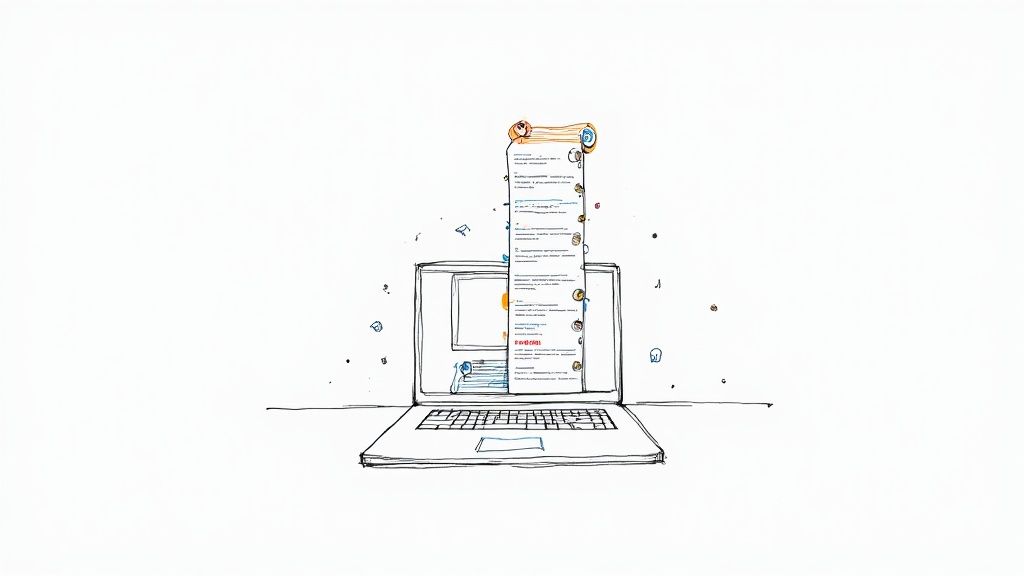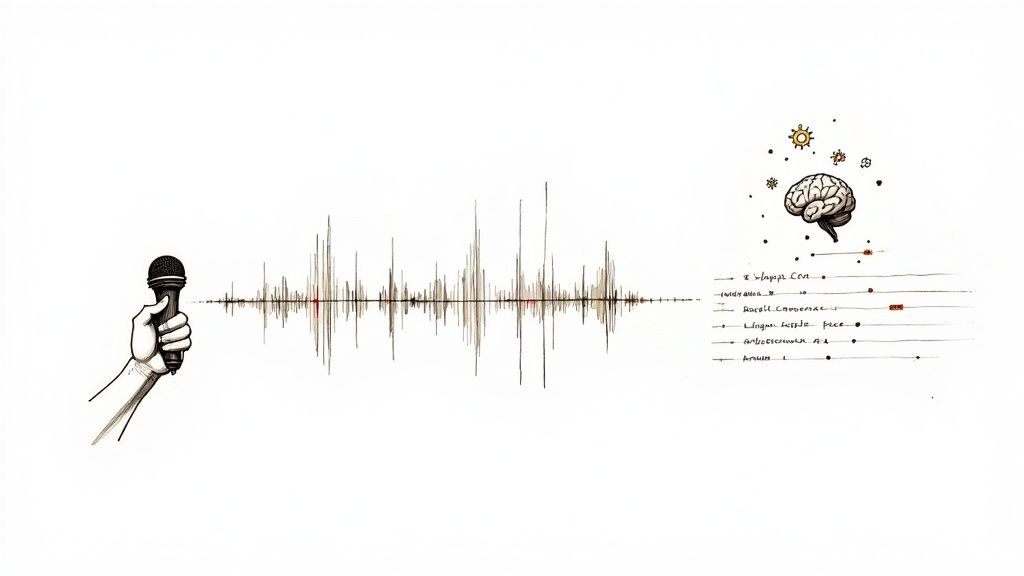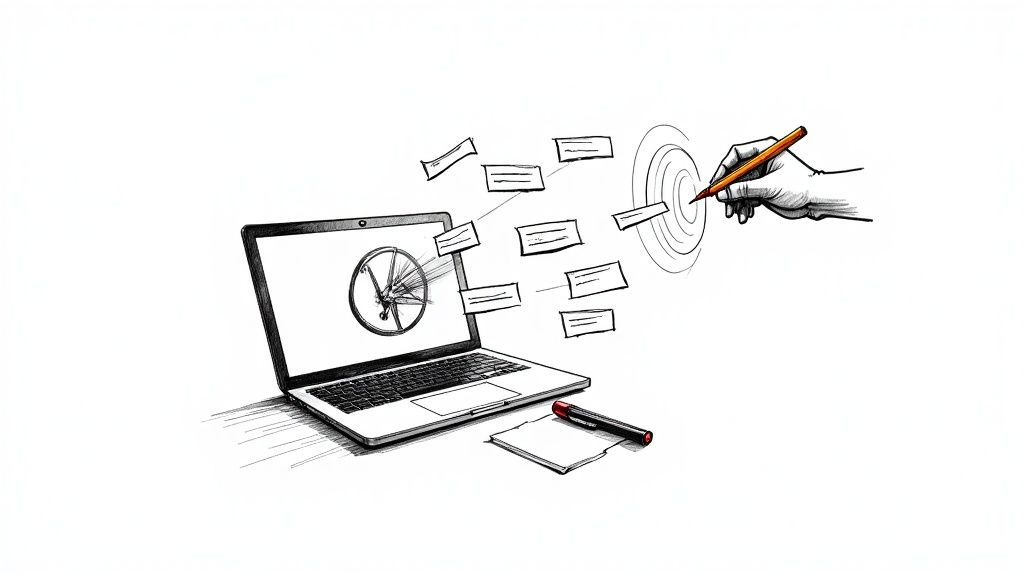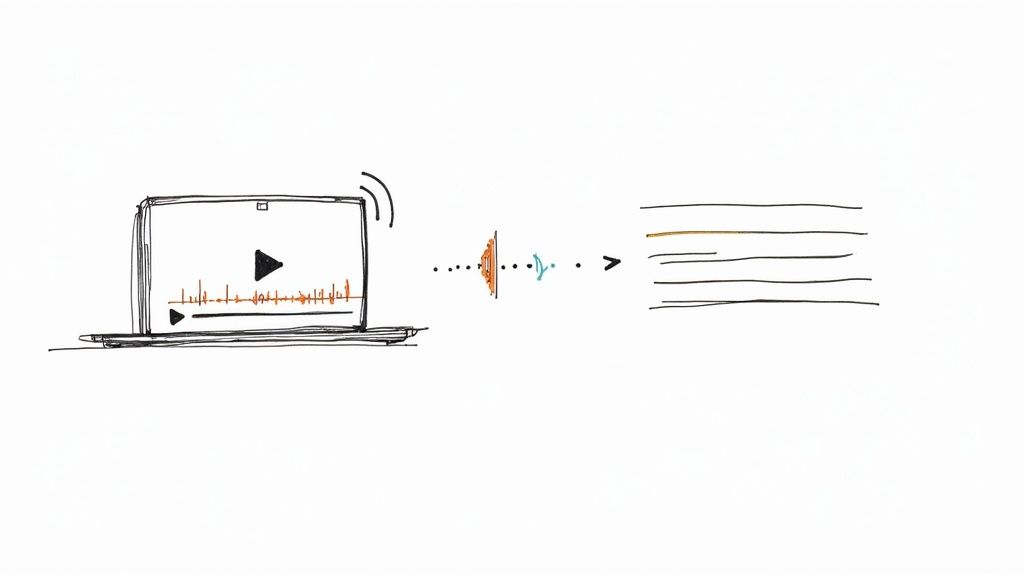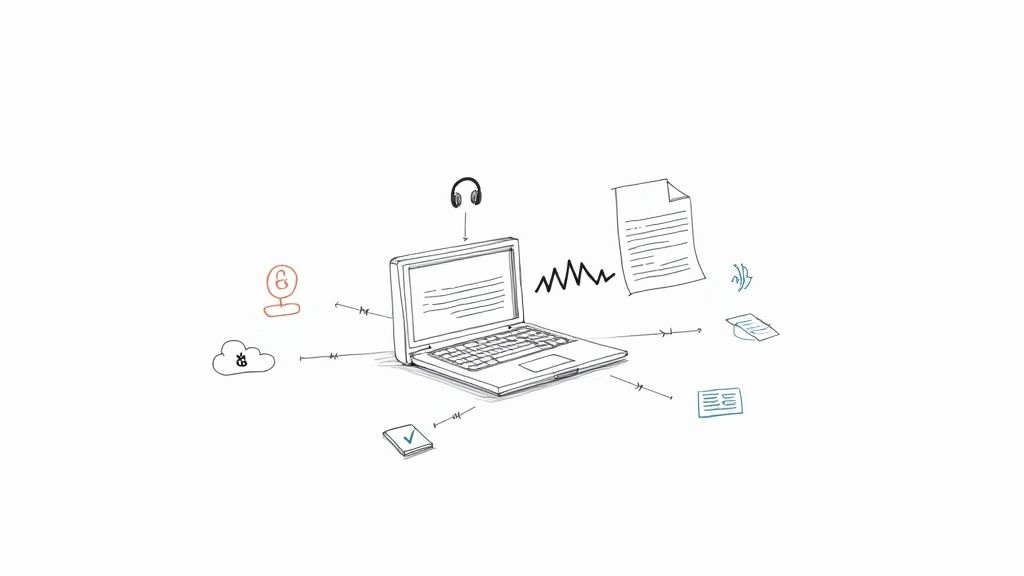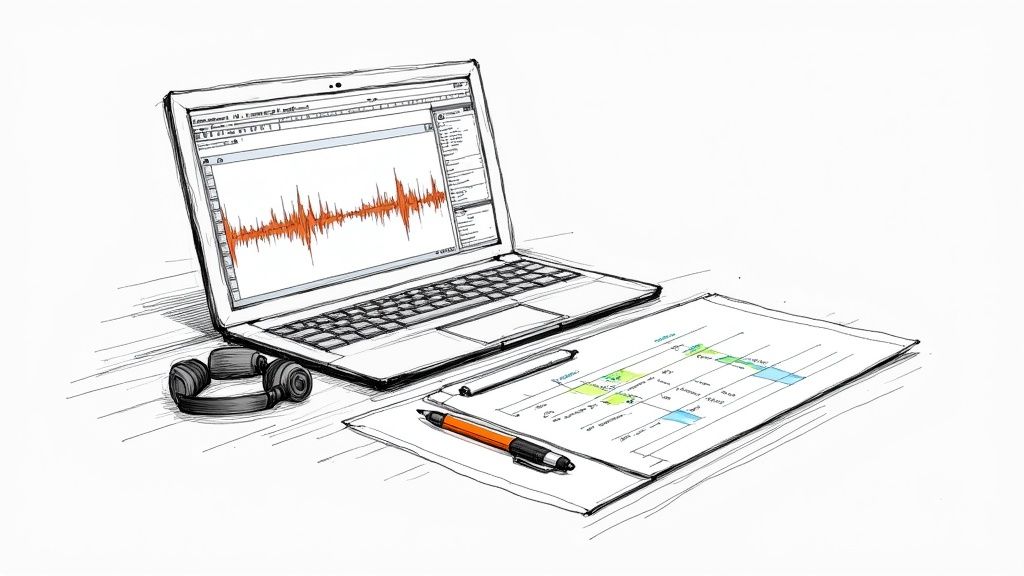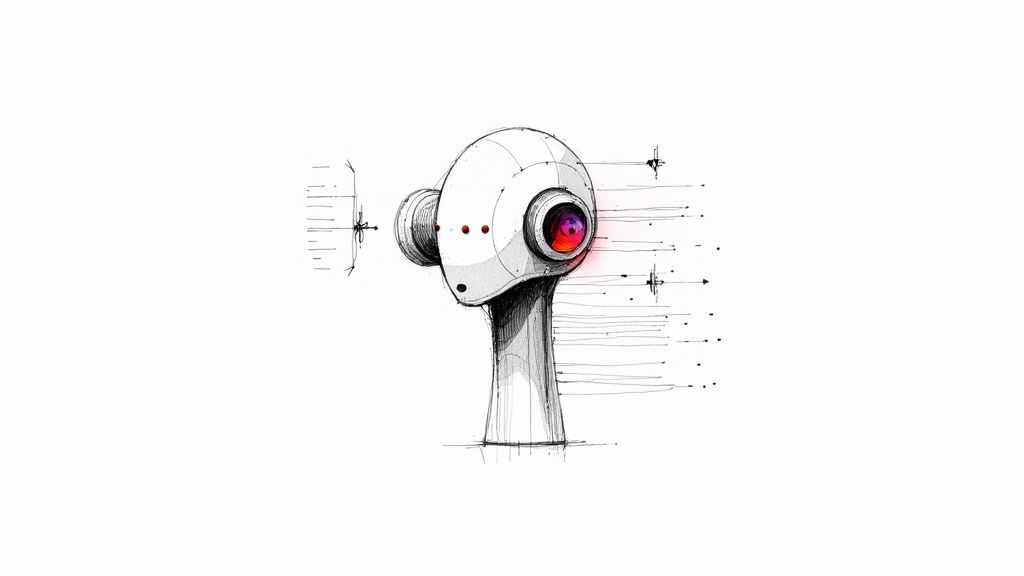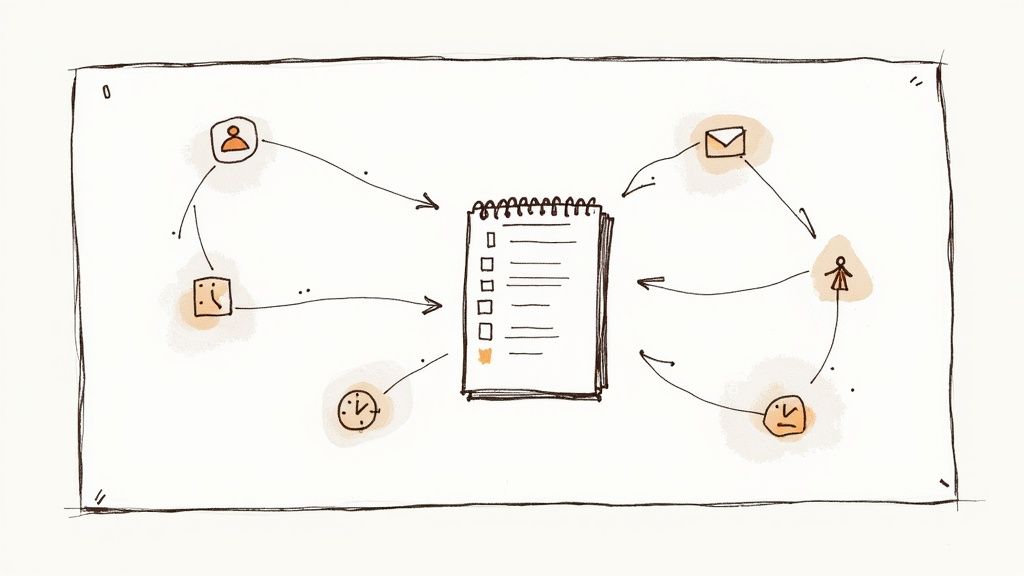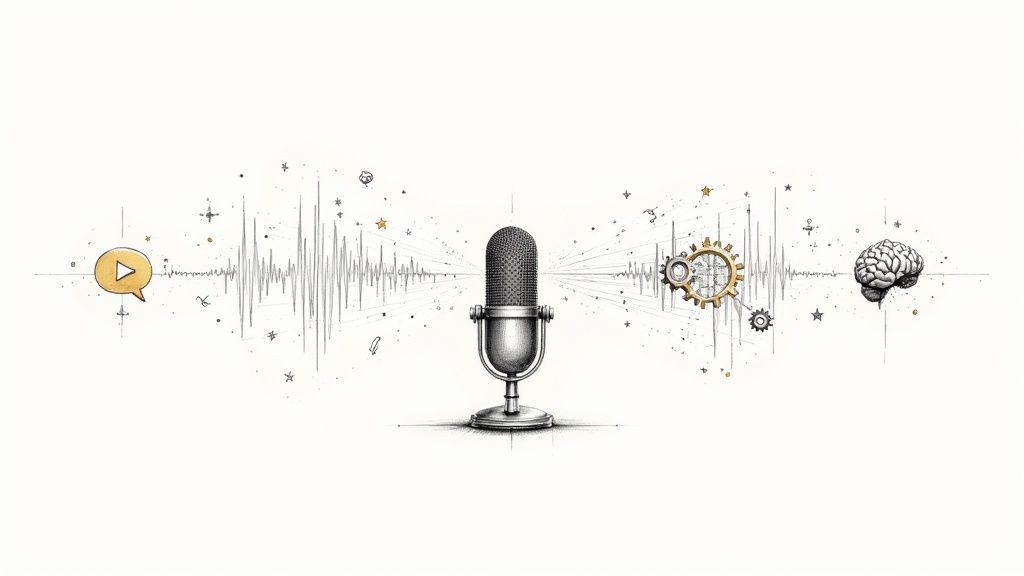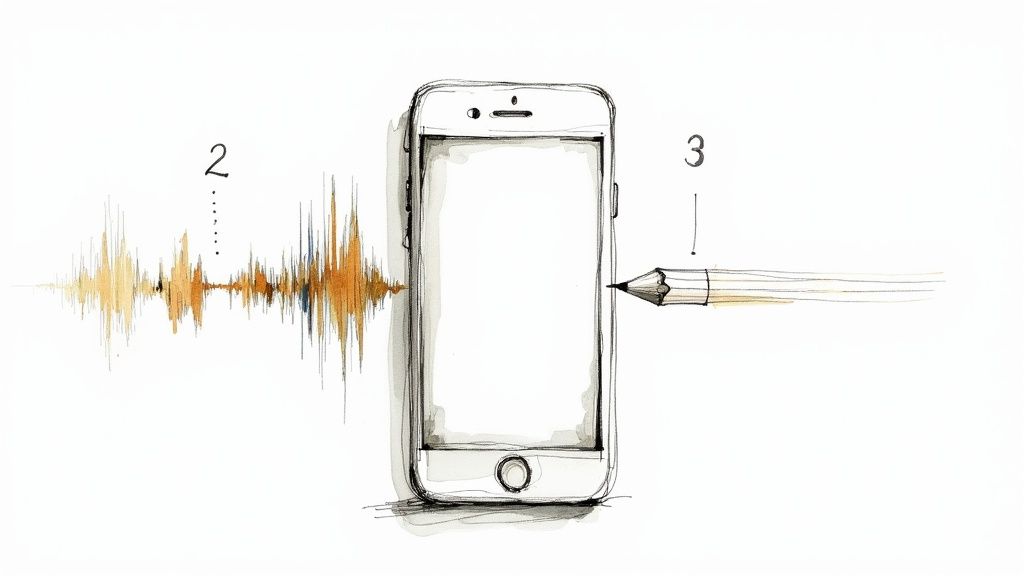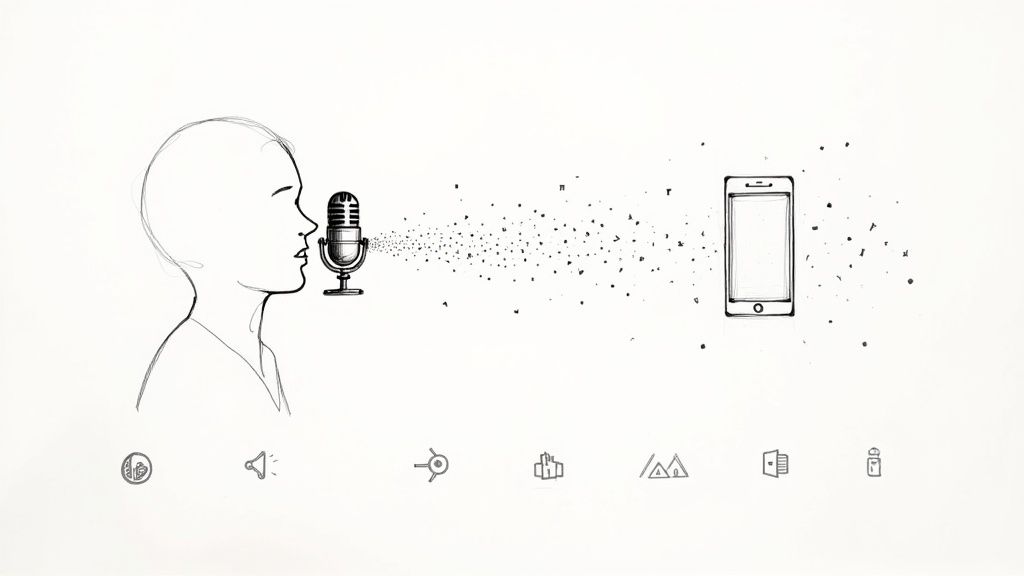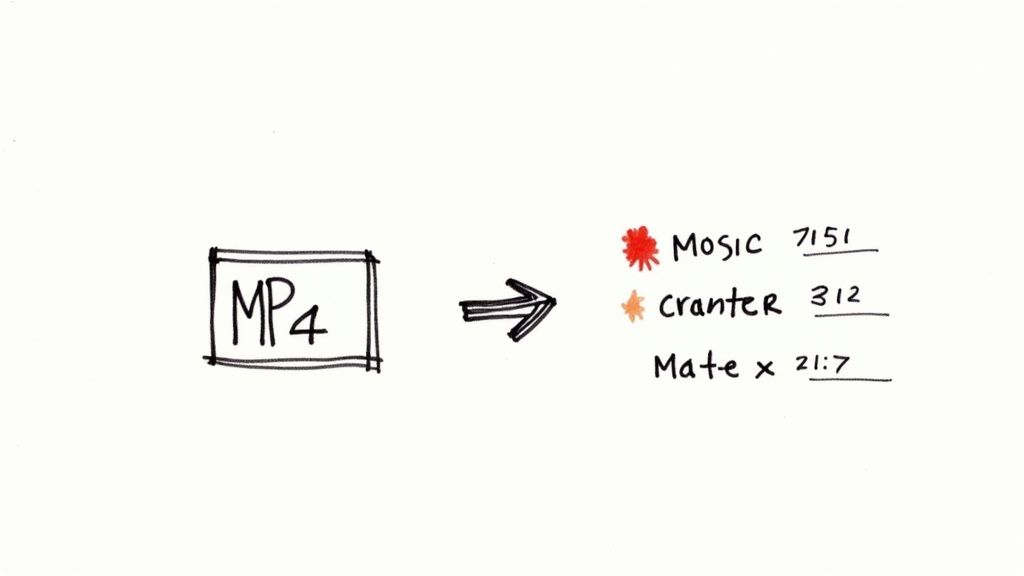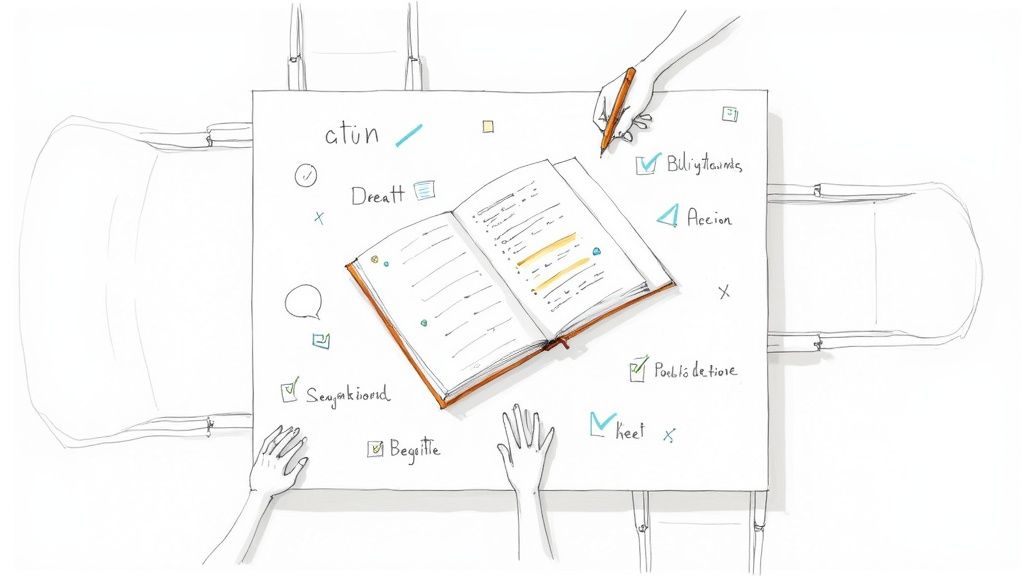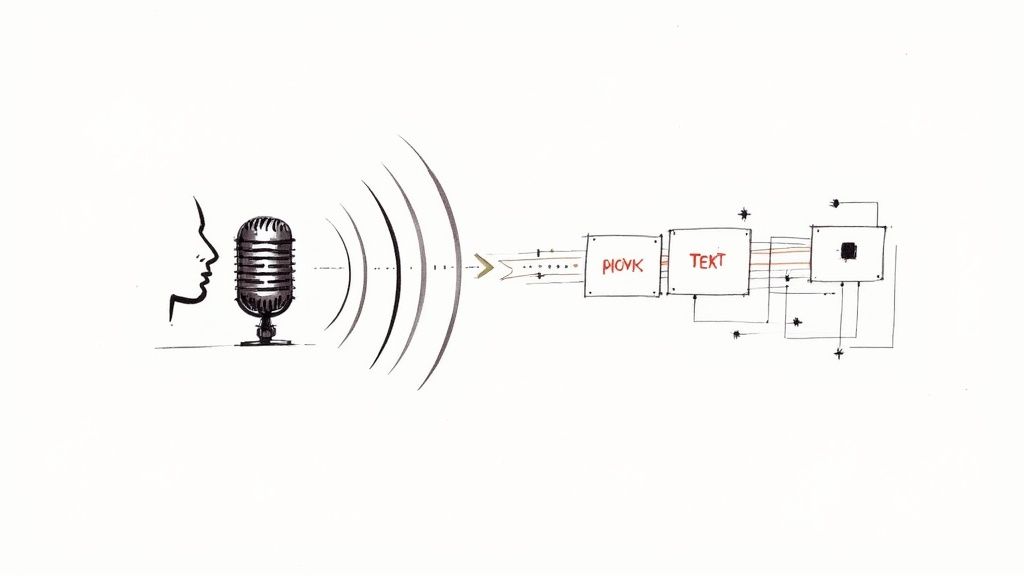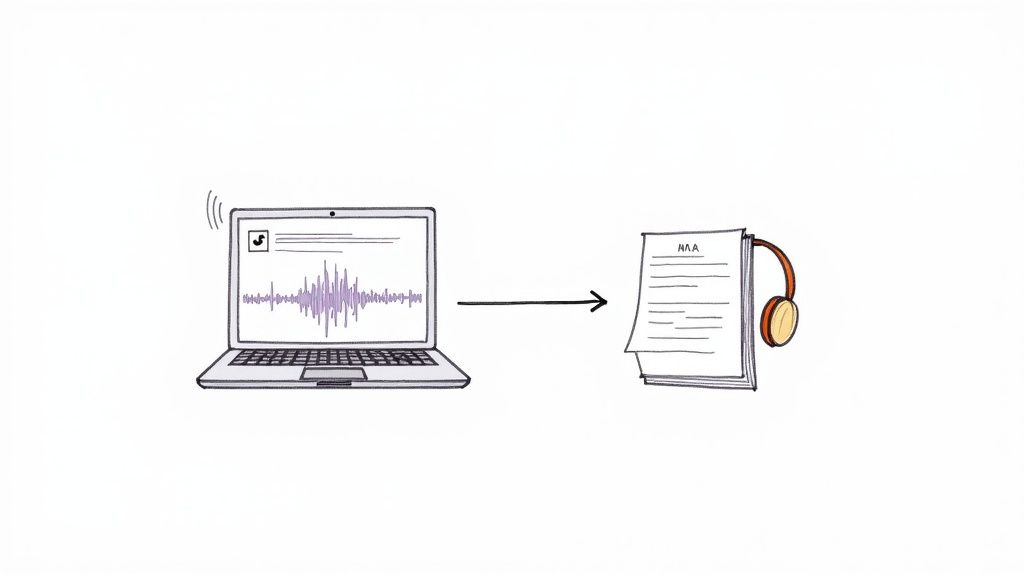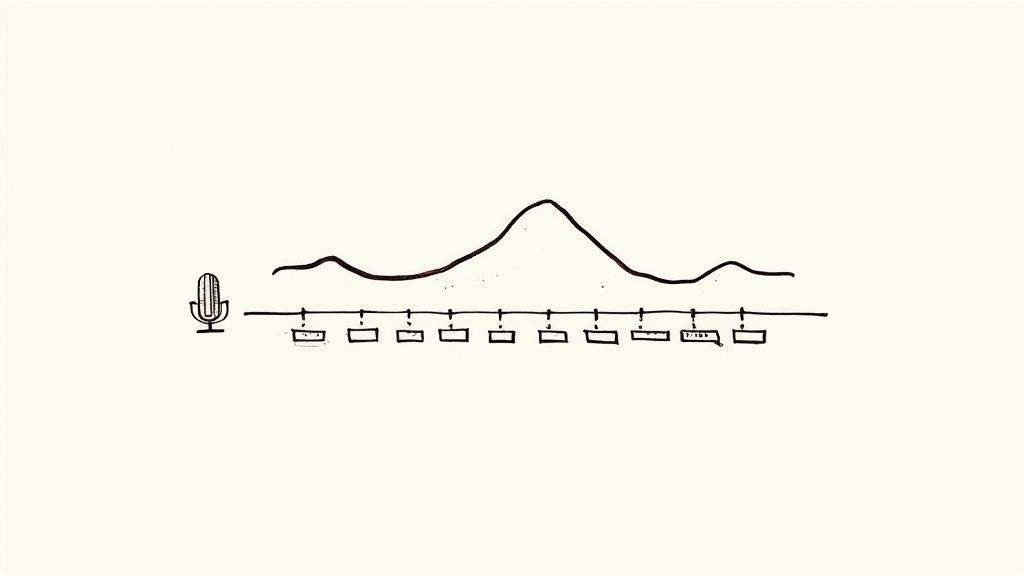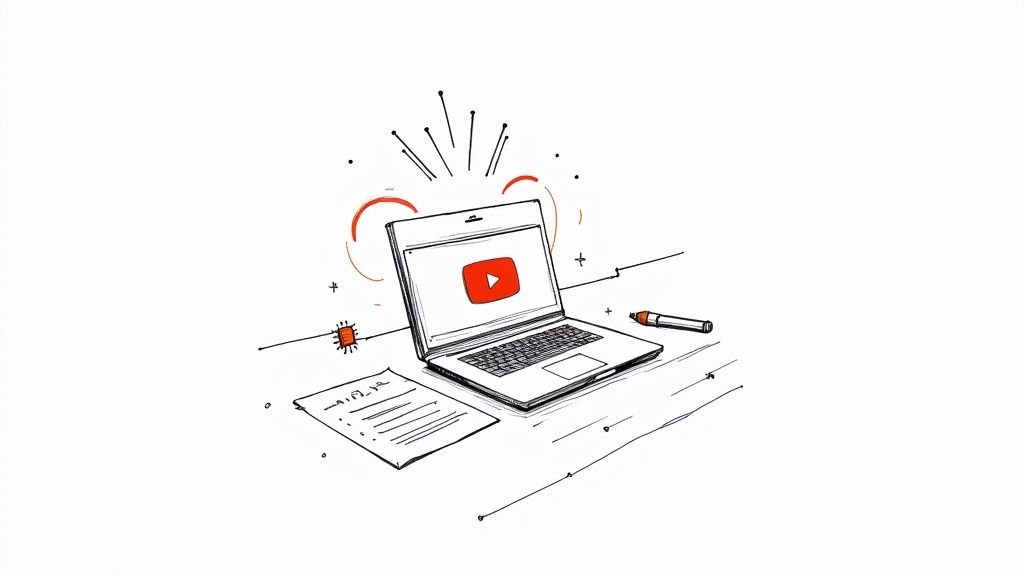
What is Audio Transcription? A Complete Guide to Speech-to-Text
At its most basic, audio transcription is the process of converting spoken language from an audio or video file into written text. Think of it as building a bridge between what we hear and what we can read, search, and analyze. This simple conversion unlocks the value trapped inside spoken content, making it more accessible and useful.
Here's a quick overview to get us started.
Audio Transcription at a Glance
This table offers a snapshot of audio transcription's core elements, covering its purpose, the methods used, and its key benefits for quick reader understanding.
Essentially, transcription transforms fleeting spoken words into a permanent, searchable text document.
How Does Audio Transcription Work?
Imagine you have a recording of a five-minute team huddle or a three-hour podcast interview. As an audio file, that information is locked in time. You have to listen through it to find anything specific. My own experience in content creation showed me how frustrating this was; I'd spend hours scrubbing through recordings just to find a single quote.
Audio transcription solves this by creating a text document you can skim, search with Ctrl+F, and pull quotes from in seconds. This conversion from sound to text transforms a conversation into a permanent, valuable asset that can be edited, shared, or archived.
The Two Main Transcription Methods
When you need to get something transcribed, you have two main choices: use a human transcriber or an AI-powered service. Each approach has its own set of trade-offs, and the right one depends on what you value most—speed, budget, or absolute precision.
The following infographic gives a great visual breakdown of how they stack up.
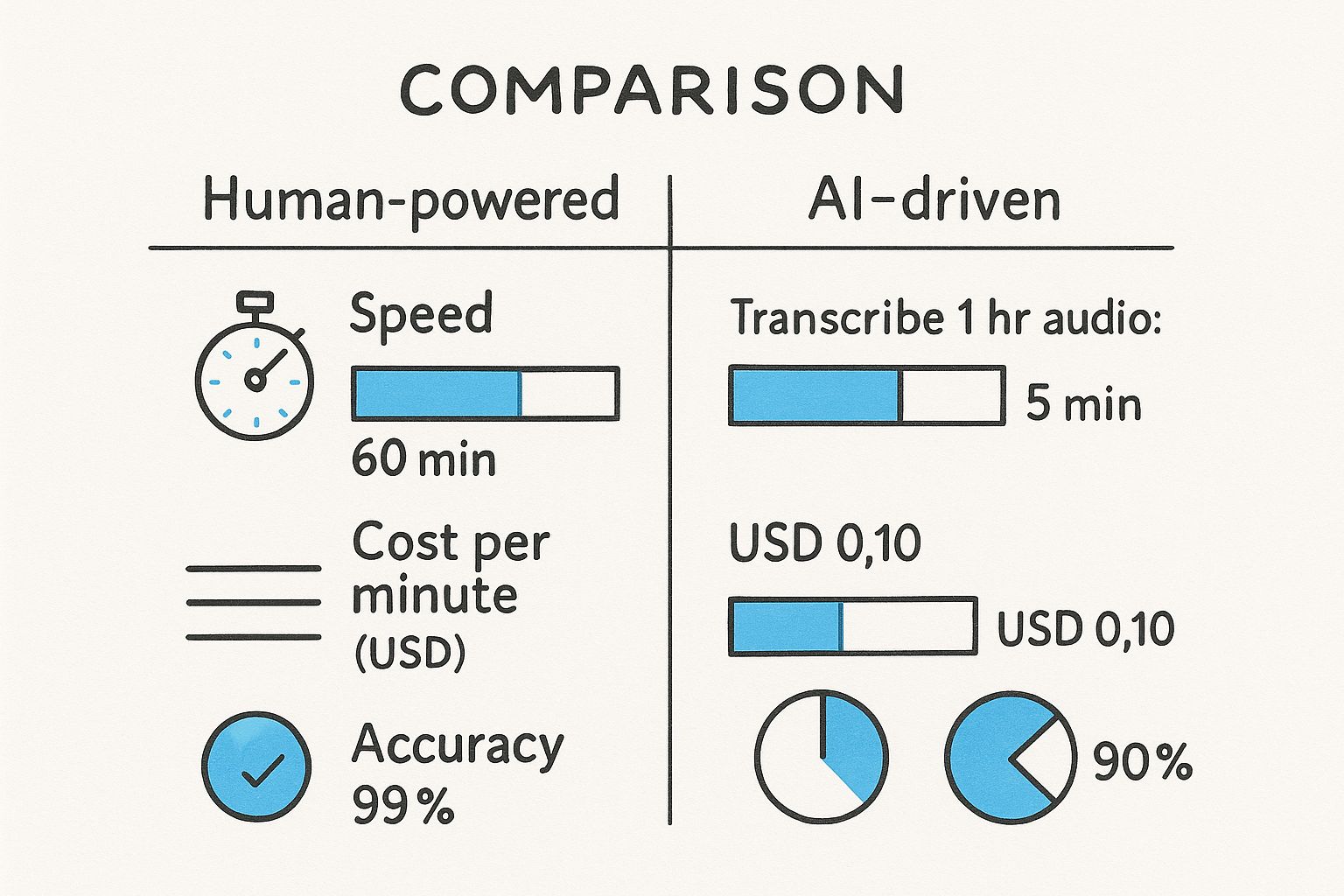
As you can see, AI has a massive advantage in speed and cost. On the other hand, a skilled human transcriber often still wins on accuracy, especially when dealing with complex audio that has background noise, heavy accents, or overlapping speakers.
Why Is Transcription So Important?
Spoken words are temporary and difficult to manage. Information shared in a meeting, a lecture, or a customer call can easily be lost or misremembered. Transcription solves that problem by creating a stable, reliable record.
Transcription empowers you to unlock the full potential of your audio and video content. It turns passive listening into an active resource you can search, analyze, and repurpose.
Once your audio is in text form, a world of possibilities opens up. You can:
- Improve Accessibility: Transcripts are a game-changer for people with hearing impairments. They also give non-native speakers a way to follow along without missing a beat.
- Boost Discoverability: Search engines can’t "listen" to your podcast or webinar, but they are incredibly good at crawling text. A transcript makes your audio content visible to Google, which can dramatically improve your SEO.
- Enable Deeper Analysis: Forget scrubbing through hours of audio. With a transcript, you can quickly find key themes, extract powerful quotes, and even analyze the sentiment of a conversation without having to listen to it all over again.
Human Precision vs. AI Speed in Transcription
When you need to get spoken words into written text, you're at a fork in the road. One path leads to the careful, detailed work of a human expert; the other, to the blazing-fast processing of an AI. Each has its own strengths, and the right choice boils down to what your project needs most: accuracy, speed, or budget.
I like to think of it like choosing between a custom-tailored suit and one bought off the rack. The bespoke suit is crafted with an artisan's touch, accounting for every nuance. The off-the-rack option offers incredible convenience and value. Both get the job done, but they serve different purposes.
The Artisan Approach: Manual Transcription
Manual transcription is the classic, human-powered method. A trained professional puts on headphones, listens carefully to your audio, and types everything out word for word. These aren't just fast typists; they are skilled listeners who can navigate the messy reality of human conversation.
This is where the human touch really makes a difference. A person can understand context, decipher thick accents, and figure out who's talking even when people interrupt each other. If your recording is full of industry jargon or has poor audio quality, a human transcriber uses their experience and research skills to get it right.
But all that expertise takes time. From my experience commissioning work, it's not uncommon for a professional to spend 3 to 4 hours transcribing just one hour of audio. Naturally, this hands-on work costs more than an automated alternative.
The Industrial Approach: AI-Powered Transcription
On the other side, you have AI-powered transcription—the high-speed engine of the speech-to-text world. This approach uses complex algorithms to analyze audio and convert it into text automatically. The entire process is over in a fraction of the time it would take a person.
An AI tool can process an hour of audio in just a few minutes, making it a game-changer for anyone with tight deadlines or large volumes of content. This efficiency also slashes costs, putting transcription within reach for students, content creators, and large companies. Modern AI has become surprisingly good, often hitting over 95% accuracy on clear recordings.
But for all its power, AI isn't perfect. It can get tripped up by the exact things that humans handle so well.
AI excels at speed and scale, processing massive amounts of audio at a low cost. But it can falter when faced with poor audio quality, heavy accents, or overlapping conversations where human nuance is still required.
AI doesn't truly understand what's being said. It might mix up similar-sounding words (like "their" vs. "there") or get stumped by acronyms without context. For mission-critical tasks where every word counts, you'll likely need a human to give it a final polish.
Making the Right Choice for Your Project
So, which one is right for you? It all comes back to your priorities. To help you decide, this table breaks down the key differences at a glance.
Comparing Human and AI Transcription
Here’s a side-by-side comparison to help you quickly weigh the pros and cons of human versus AI transcription based on accuracy, speed, cost, and best-fit scenarios.
In the end, choosing between these two powerful approaches is about matching the tool to the task. If you need flawless accuracy and can afford the time and cost, a human expert is your best bet. But if you need to process a ton of content quickly and affordably, an AI solution like Whisper AI is the way to go. The smartest choice is the one that fits your project's goals perfectly.
Why the Demand for Transcription Is Exploding
Let's be honest, audio transcription used to be a pretty niche service, mainly associated with courtrooms or doctors' offices. But that's all changed. Today, transcription is central to how we use information, all because we're creating and consuming an incredible amount of audio and video.
Every podcast, webinar, Zoom call, and TikTok video is packed with information. The problem? It's locked up. You can't hit "Ctrl+F" on a podcast or quickly skim a two-hour meeting recording. This is the exact problem transcription solves, and it's why converting speech to text is no longer a niche service but a massive need in almost every industry.
The Content Tsunami
It’s not just the amount of content; it's who's creating it. A decade ago, it was mostly professional studios. Now, anyone with a smartphone can launch a podcast or host a webinar, contributing to a global flood of spoken information.
This content explosion creates a huge opportunity. A business wants to mine customer feedback from thousands of support calls. A marketer needs to spot trends in video reviews. An online educator wants to make their lectures more accessible. Transcription is the key that unlocks the value trapped inside all this audio and video.
The modern economy runs on data, and a huge portion of that data is now spoken, not written. Audio transcription is the essential bridge that converts unstructured spoken words into structured, analyzable text.
The market numbers back this up. The global audio transcription software market is already a big deal, valued at around $2.5 billion in 2025. But it's not stopping there. It's projected to grow at a Compound Annual Growth Rate (CAGR) of 15% between 2025 and 2033, all thanks to this non-stop creation of audio and video. You can explore more data on the audio transcription market to see just how big this trend is.
Unlocking Value Across Sectors
This isn't just about handling a massive volume of files; it's about the very real, practical value transcription delivers. When you understand what audio transcription is and see how it's used, it's clear why so many are jumping on board.
- Media and Entertainment: For podcasters and YouTubers, transcripts are an SEO goldmine. They make audio and video content discoverable through search engines. They also make it incredibly easy to pull quotes for social media or turn a single episode into a dozen different blog posts.
- Healthcare: Doctors are using medical transcription to capture patient notes accurately without getting bogged down in paperwork. This frees them up to focus on what matters: the patient sitting in front of them.
- Legal: In the legal world, every single word counts. Certified transcripts of depositions and court hearings are the official record, ensuring nothing is missed or misremembered.
- Corporate and Business: Companies are transcribing meetings to create a searchable history of decisions and assign clear action items. They're also analyzing sales calls and customer interviews to get unfiltered insights into what their market really thinks.
At the end of the day, the booming demand for transcription boils down to one powerful function: it turns a spoken moment into a permanent, searchable, and incredibly valuable asset. As our world gets louder, the need to translate all those voices into text isn't just growing—it's becoming essential.
How Transcription Powers Different Industries
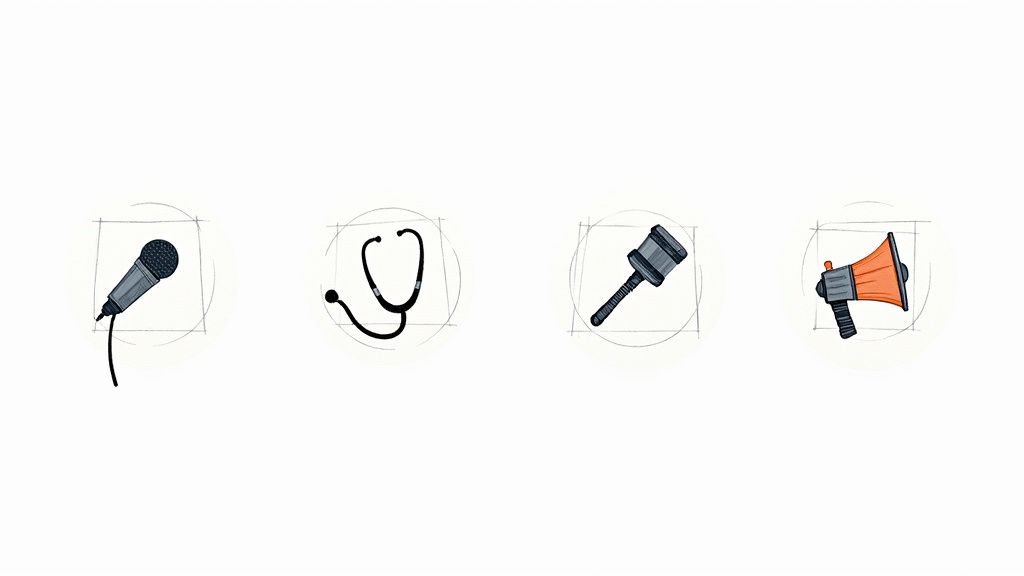
It’s one thing to know what transcription is, but its real power comes alive when you see it at work in the real world. For countless professionals, it's not just a handy tool—it's the backbone of their workflow, helping them solve problems, save precious time, and find new opportunities. From bustling newsrooms to quiet courtrooms, turning spoken words into text is a daily necessity.
And this isn't a niche activity. The demand is massive. The transcription market in the United States alone was worth an estimated $30.42 billion in 2024. It’s on track to climb to nearly $41.93 billion by 2030, a clear sign of just how essential this service has become across the legal, medical, and media sectors. You can dig into the numbers yourself in the U.S. transcription market analysis from Grand View Research.
This growth isn't just a number on a chart; it's driven by real, practical uses that make people’s jobs easier and more effective.
Journalism and Media Production
Ask any journalist—deadlines are everything. Picture a reporter coming back from a crucial, hour-long interview. The old way meant spending hours hunched over a recording, pressing play and pause, trying to type out every important quote. It was a grind that ate up valuable time that could have been spent writing.
Audio transcription completely flips that script. Now, that same reporter can just upload their audio file and get a full text version back in minutes. This is a total game-changer.
- Find killer quotes instantly: No more scrubbing back and forth through the audio. A simple "Ctrl+F" on the transcript brings up the exact phrase they need.
- Get the facts right: A direct transcript means no more accidental misquotes, which is vital for maintaining credibility.
- Stretch content further: That single interview transcript can be sliced and diced into a blog post, a series of social media updates, or the foundation for a long-form article. We actually have a great guide on how to transcribe interviews efficiently if this is your world.
Freed from tedious manual work, reporters can now focus their energy on what really matters: analyzing the story and telling it in a powerful way.
Healthcare and Medical Documentation
In medicine, you can’t afford mistakes, and you can never have enough time. Doctors have traditionally spent huge chunks of their day buried in administrative work, especially when it comes to documenting patient visits. Every minute spent typing is a minute not spent with a patient.
This is where medical transcription steps in. A doctor can simply dictate their notes right after an appointment, and that audio is quickly turned into a perfect written entry for the patient's electronic health record (EHR).
For healthcare professionals, transcription isn't just about saving time; it’s about improving the quality of care by allowing them to focus on the patient, not the paperwork.
This simple shift ensures that every diagnosis, treatment plan, and bit of patient history is captured with precision. It cuts down on the risk of human error and, most importantly, frees up doctors to do what they do best.
Legal and Corporate Compliance
The entire legal system runs on the written word. Depositions, courtroom proceedings, client meetings—it all has to be documented perfectly. The transcript is often the official record, and a single mistake can have massive ripple effects.
This is why specialized human transcribers are so critical in the legal field. They create certified transcripts that hold up in court, capturing every word, pause, and interruption with painstaking accuracy.
The corporate world relies on transcription just as heavily for compliance. Think about it: board meetings, shareholder calls, and internal investigations all need a clear, searchable paper trail. Transcribing these events creates an official record of who said what, ensuring transparency and helping companies meet strict regulatory rules. It's an indispensable tool for keeping everything above board.
The AI Revolution in Speech-to-Text Technology
For a long time, human transcription was the only way to get truly accurate results. But recently, a massive leap forward in artificial intelligence didn't just move the goalposts—it changed the entire game. The slow, steady progress we’d seen for years was suddenly replaced by an explosion in capability.
Suddenly, high-quality, instant transcription wasn't a pipe dream; it was something anyone could access. This wasn't a minor software update. It was a fundamental shift in what we thought was possible with speech-to-text.
At the heart of this change are incredibly powerful AI models, and one of the best examples is OpenAI's Whisper. It was trained on a mind-boggling 680,000 hours of diverse audio scraped from the web. This colossal dataset gave it an uncanny ability to understand not just clean speech, but accents, background chatter, and complex jargon with near-human accuracy.
This shift is making serious waves economically. The global AI transcription market, a niche within the larger industry, was valued at $4.5 billion in 2024. But it's projected to skyrocket to $19.2 billion by 2034, growing at a compound annual rate of 15.6%. North America is leading the charge, holding over 35.2% of the market share. For anyone tracking the money side, you can find more details about the AI transcription market growth on Market.us.
How Does AI Actually Learn to Understand Speech?
So, how does a tool like Whisper pull this off? It’s not magic—it’s a combination of two powerful concepts: machine learning and natural language processing.
- Machine Learning (ML): This is basically the AI's education. By sifting through those hundreds of thousands of hours of audio paired with their written transcripts, the model starts to recognize patterns. It learns how certain sound waves correlate to specific letters and words, almost like a toddler learning to connect the sound "ball" with the round toy in front of them.
- Natural Language Processing (NLP): If ML is the education, NLP is the contextual intelligence. It’s what helps the AI do more than just match sounds. NLP allows the model to predict the most likely next word, figure out the difference between "their," "there," and "they're," and understand the flow of a real conversation.
Putting these two together is what allows the AI to move beyond just hearing sounds to actually comprehending speech. This is the breakthrough that has unlocked features we could only dream of in older automated systems.
The real breakthrough in AI transcription isn't just speed; it's the ability to process the messiness of human speech—accents, interruptions, and all—with a level of understanding that rivals a human listener.
This chart from OpenAI's own research really drives the point home, showing how Whisper stacks up against other models on various audio datasets.
Notice how Whisper consistently maintains a low word error rate? That's the data proving its reliability across all sorts of real-world audio.
The Impact of Advanced AI Models
The arrival of sophisticated models like Whisper has completely leveled the playing field. What used to demand a professional service or expensive, clunky software is now available in easy-to-use tools.
You can now get incredibly accurate transcripts—complete with timestamps and speaker labels—in just a few minutes. If you want to see how this is done, our guide on how to use AI to convert audio to text breaks it down. This new generation of AI empowers everyone, from YouTubers to corporate legal teams, to finally tap into the value locked away in their audio files, quickly and without breaking the bank.
Practical Tips for Getting Accurate Transcripts
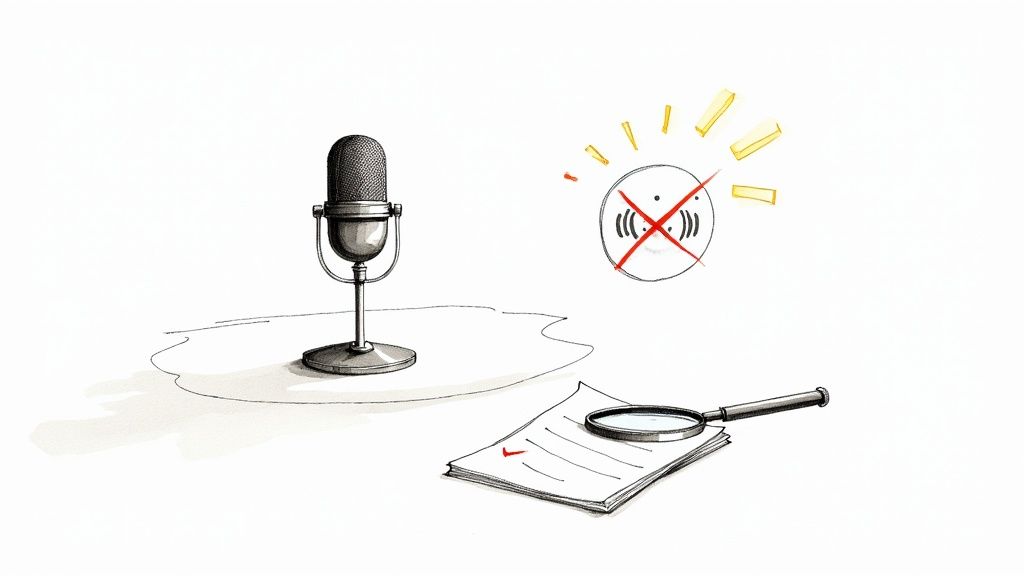
It doesn't matter if you're using a human service or a sophisticated AI—the quality of your transcript hinges entirely on the quality of your source audio. Based on my experience, taking a few simple steps before you even hit record can drastically improve your results and save a ton of editing headaches.
There's a saying in this field: garbage in, garbage out. Even the most powerful AI will trip over muffled voices, loud background noise, or people talking over each other. When you give the system clean, clear audio, you're doing the single most important thing to guarantee an accurate transcript.
Preparing for a Clean Recording
Before you start that interview, podcast, or meeting, run through this quick mental checklist. These small tweaks make a world of difference.
- Choose the Right Microphone: Your phone's built-in mic might be convenient, but an external microphone is a game-changer. A simple lapel mic or a quality USB mic will capture crisp, direct sound, cutting down on room echo and fuzzy audio.
- Minimize Background Noise: Find the quietest spot you can. Shut the windows to block street sounds, turn off the air conditioner or fan, and put your phone on silent. Every little noise you remove is one less thing the transcription AI has to struggle with.
- Speak Clearly and Directly: Remind everyone to speak one at a time and enunciate. It also helps to stay a consistent distance from the microphone to keep the volume level.
Optimizing the Transcription Process
Once you've got a great recording, there are a couple of final things you can do to help the software nail the specifics, especially if you're dealing with technical jargon or industry-specific terms.
The goal is to provide as much context as possible. An AI can recognize words, but providing a glossary for technical terms or acronyms helps it make smarter choices when faced with ambiguity.
For instance, if your audio mentions "Kubernetes," the AI might hear it as "cooper Nettie's." But if you give it a list of key terms beforehand, you can guide it toward the right spelling. This is a powerful feature in many automatic transcribe software tools.
And finally, always proofread. No system is 100% perfect. A quick human review is your last line of defense against embarrassing little mistakes. Spending just five minutes scanning the final text will ensure your transcript is polished and ready to go.
Common Questions About Audio Transcription
As you start exploring transcription, you'll naturally run into a few key questions. Getting these answers straight helps you pick the right tools and set yourself up for success from the get-go.
Let's dive into some of the most common things people ask when turning speech into text.
How Accurate Is AI Audio Transcription?
Modern AI transcription has gotten remarkably good, but it's not infallible. Under perfect conditions—think a high-quality recording of a single, clear speaker with no accent—a top-tier model like OpenAI's Whisper can hit 99% accuracy. That’s more than enough for things like meeting notes or video captions.
But the real world is messy, and that's where things get tricky. Accuracy can take a hit when the AI grapples with:
- Loud background noise: A café or a windy street can easily muddle the words.
- Crosstalk: Multiple people talking over each other is a nightmare for any transcription system.
- Strong accents or niche jargon: If the AI hasn't been trained on specific dialects or industry terms, it can get confused.
While AI is incredibly accurate for most day-to-day tasks, its performance hinges on audio quality. For high-stakes content like legal depositions or medical dictation, you'll always want a human to do a final review to catch those subtle but crucial mistakes.
How Much Does Audio Transcription Cost?
The price tag for transcription can swing wildly depending on whether a human or an AI is doing the work. It really comes down to your budget and what you need.
Human transcription is the white-glove service. Professionals typically charge by the audio minute, with rates falling anywhere between $1.00 and $5.00. The price shifts based on things like turnaround time, audio complexity, and extra requests like timestamps.
AI-powered services, on the other hand, are a game-changer for affordability. You’ll often see pricing at just a few cents per minute, or you can get a great deal with a monthly subscription. For most people, it's a simple trade-off: the near-perfect precision of a human expert versus the lightning speed and low cost of an AI.
What Is the Best Audio File Format for Transcription?
This might feel like a minor technical detail, but the right file format can give you a slight edge. From a purely technical standpoint, lossless formats like WAV or FLAC are the gold standard. They don't compress the audio at all, meaning the AI gets every last bit of data to analyze.
That said, don't sweat it too much. Most modern transcription platforms are more than capable of handling common compressed files like MP3 or M4A without any issue.
The truth is, the quality of the recording itself matters infinitely more than the file type. A crisp, clear MP3 will always beat a muffled, noisy WAV file. Your top priority should always be capturing clean audio from the start.
Ready to turn your audio into accurate, searchable text in minutes? Try Whisper AI and experience the power of state-of-the-art transcription and summarization for yourself. Get started for free at WhisperBot.ai.

